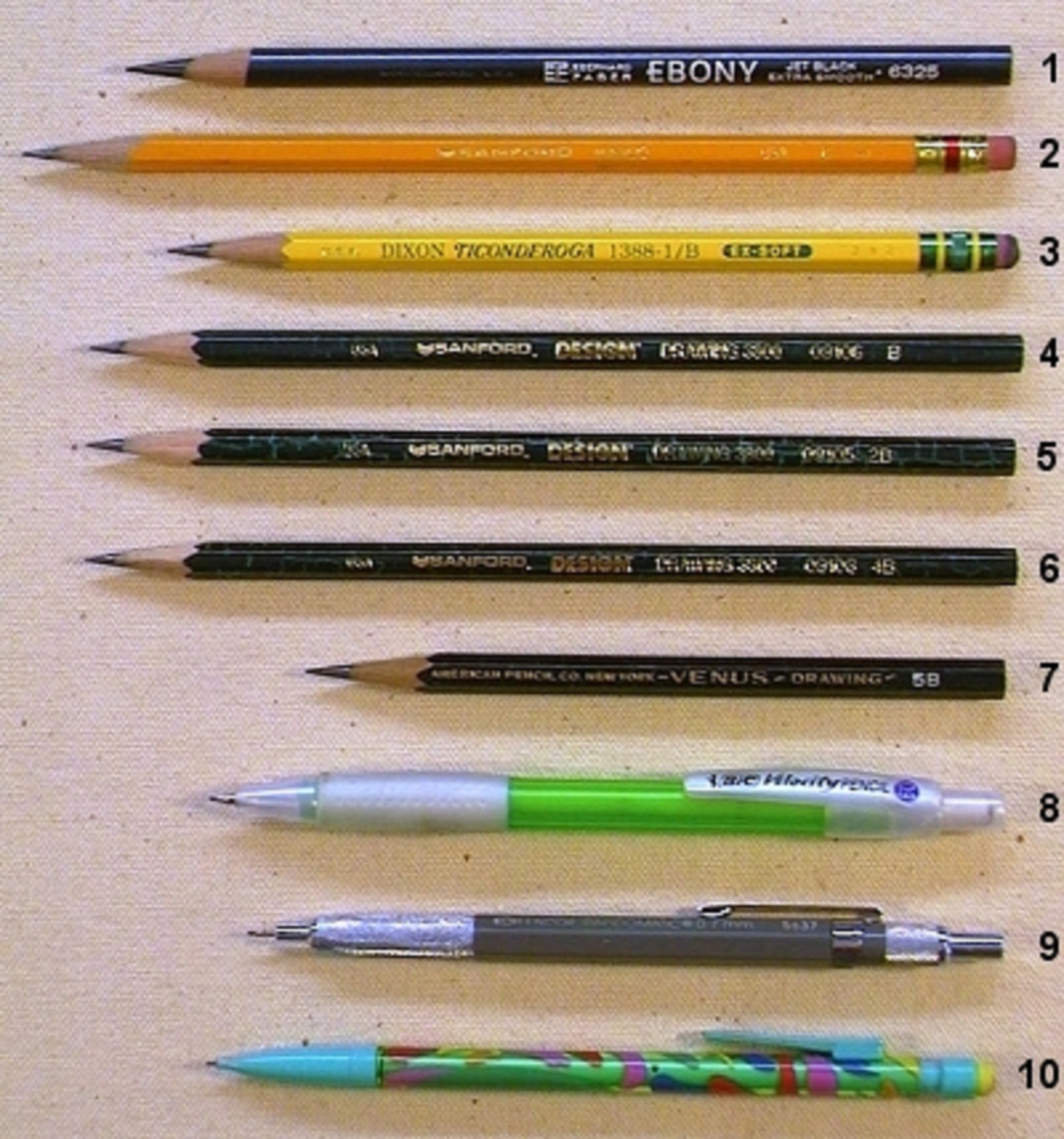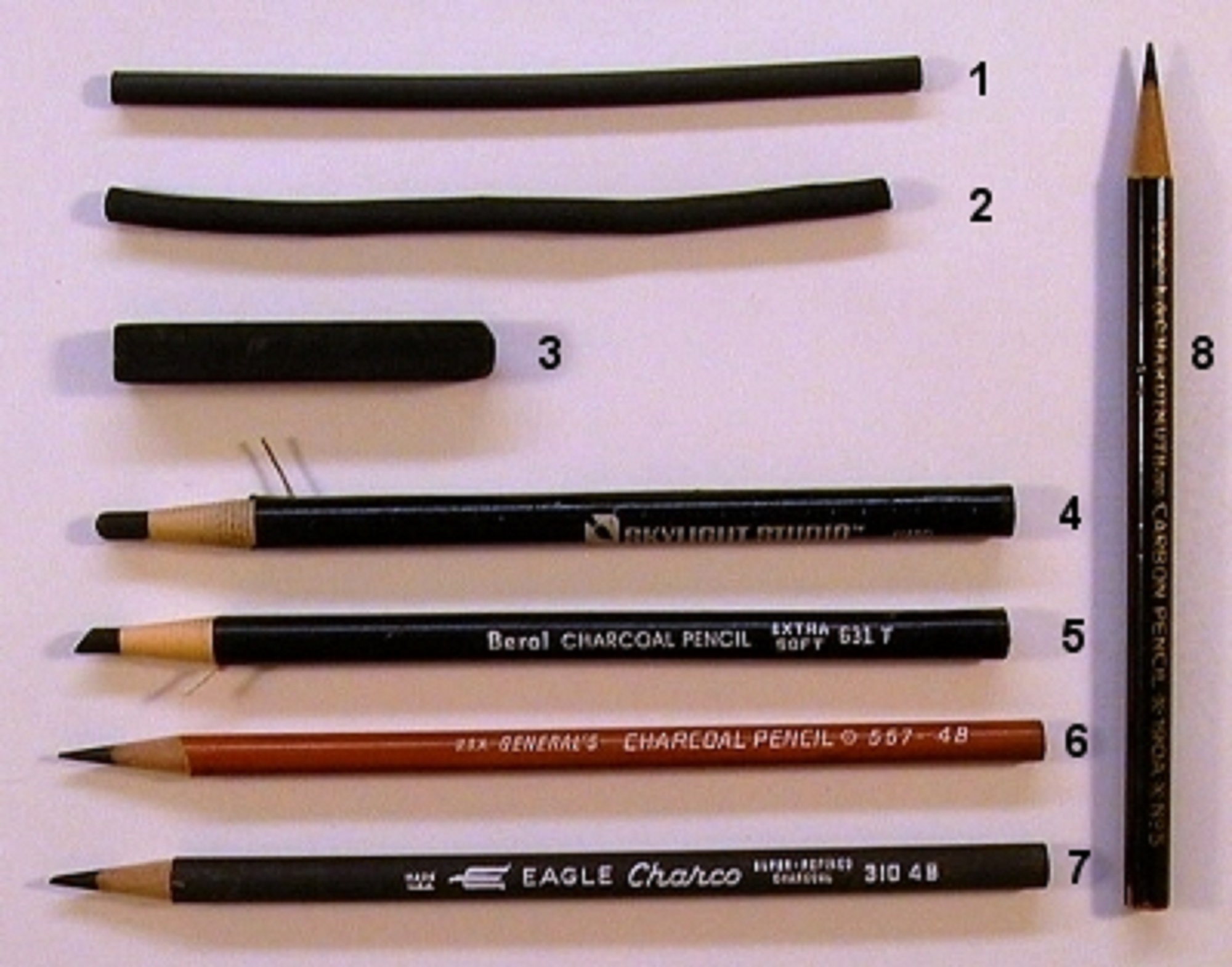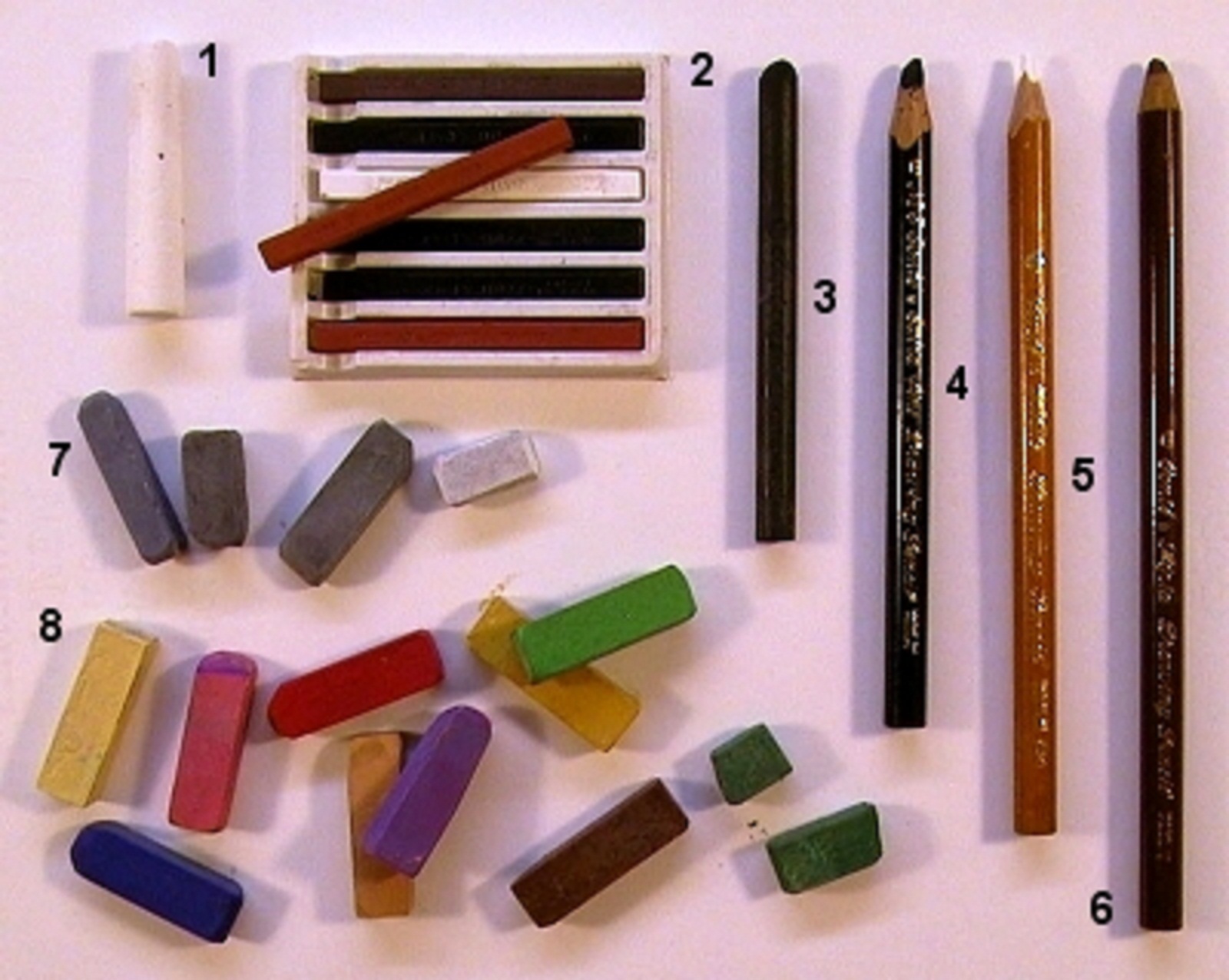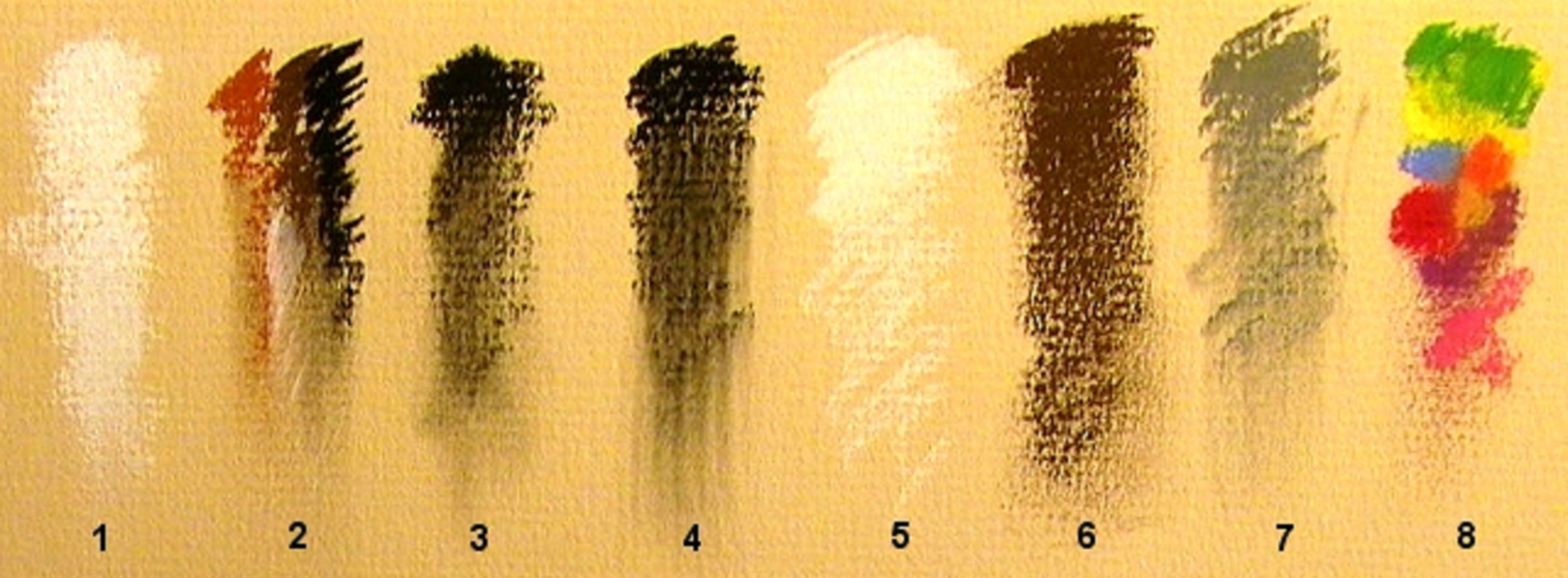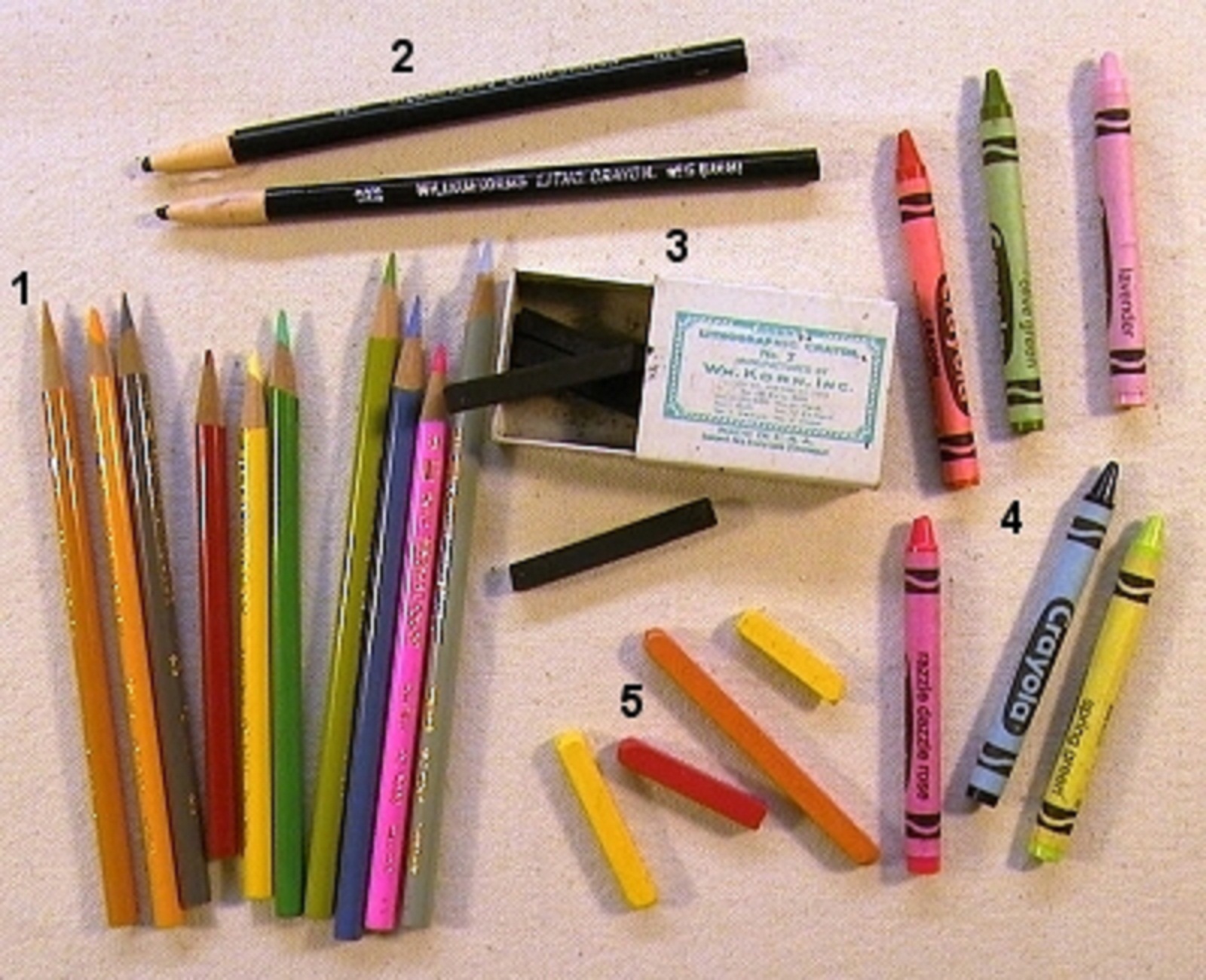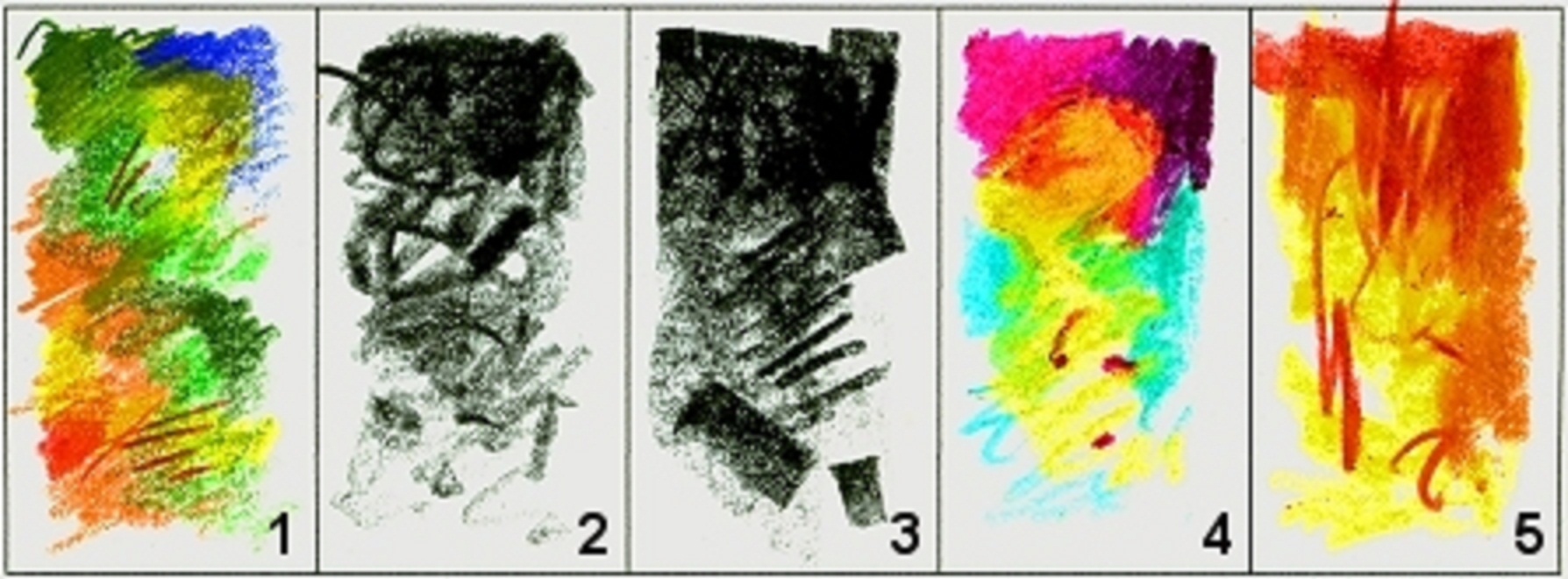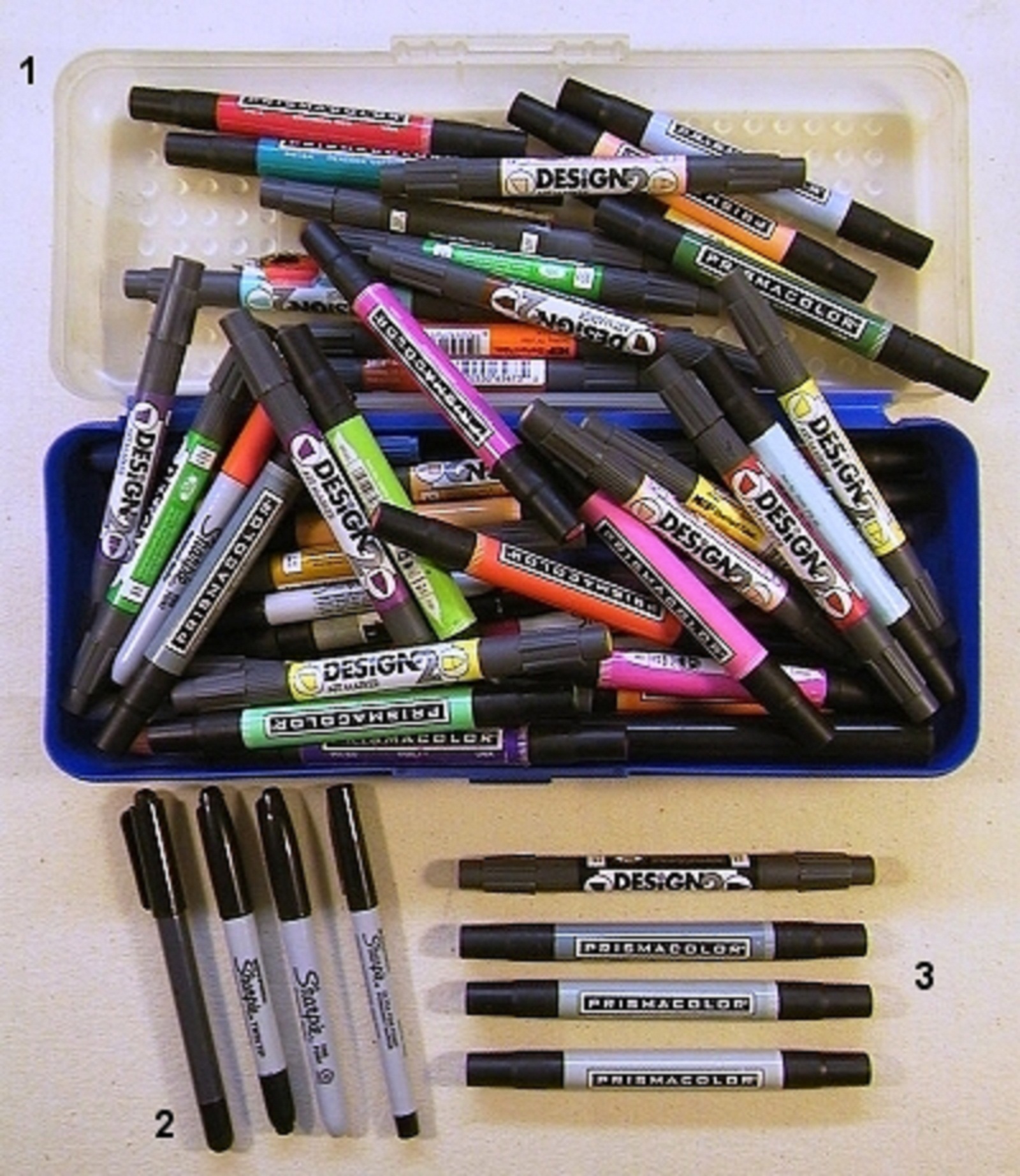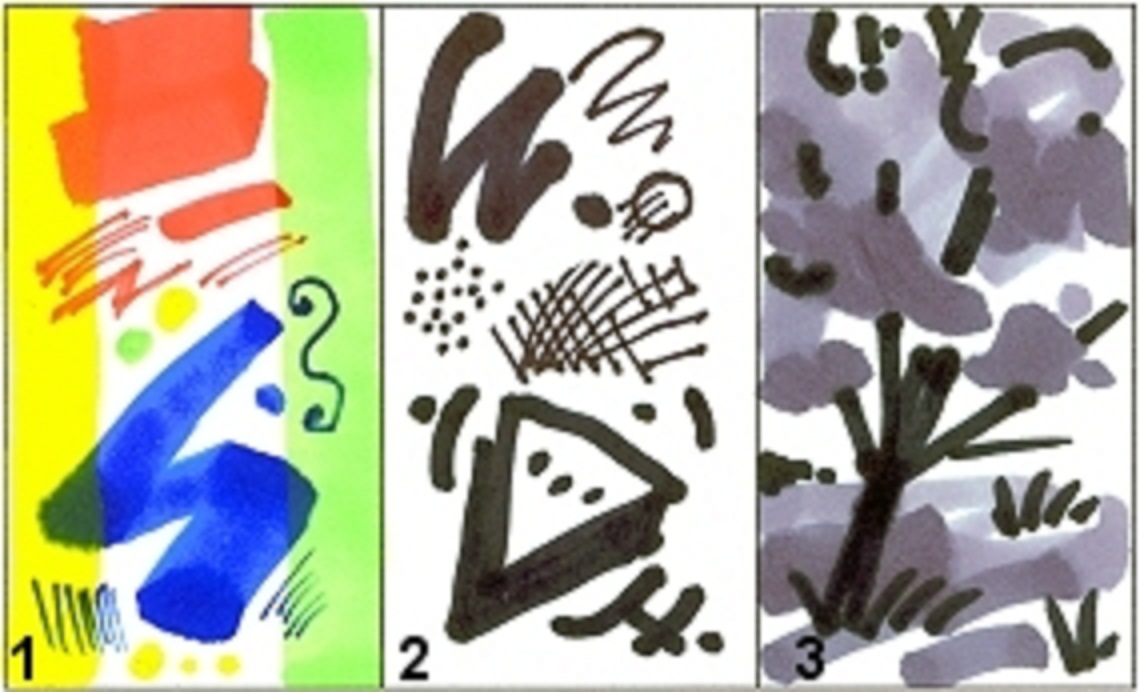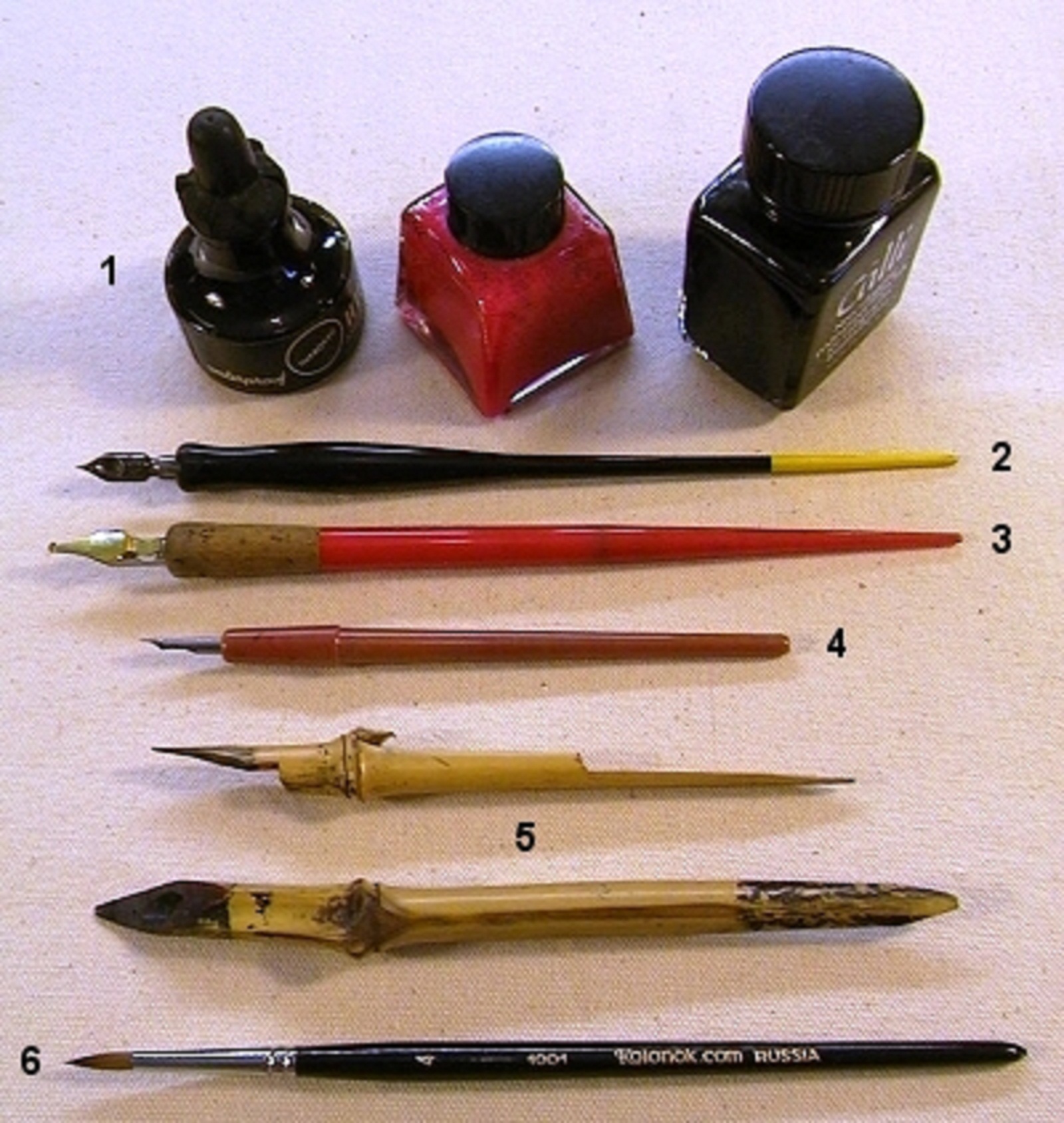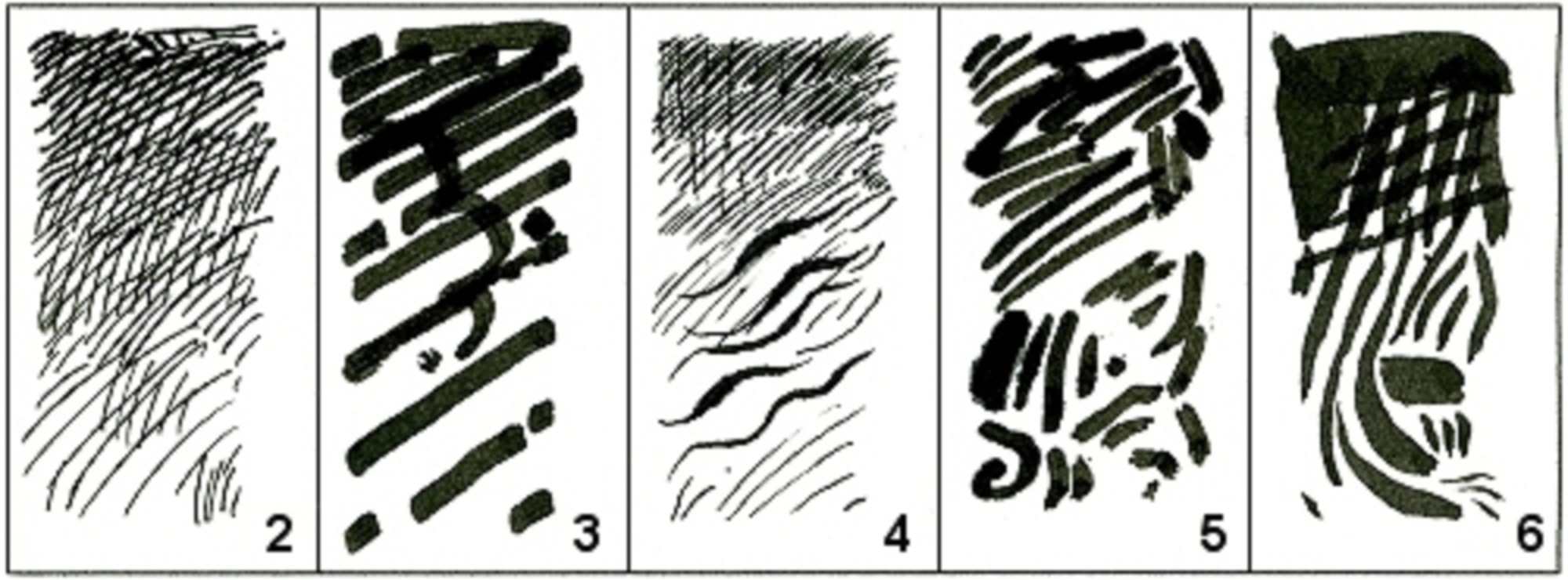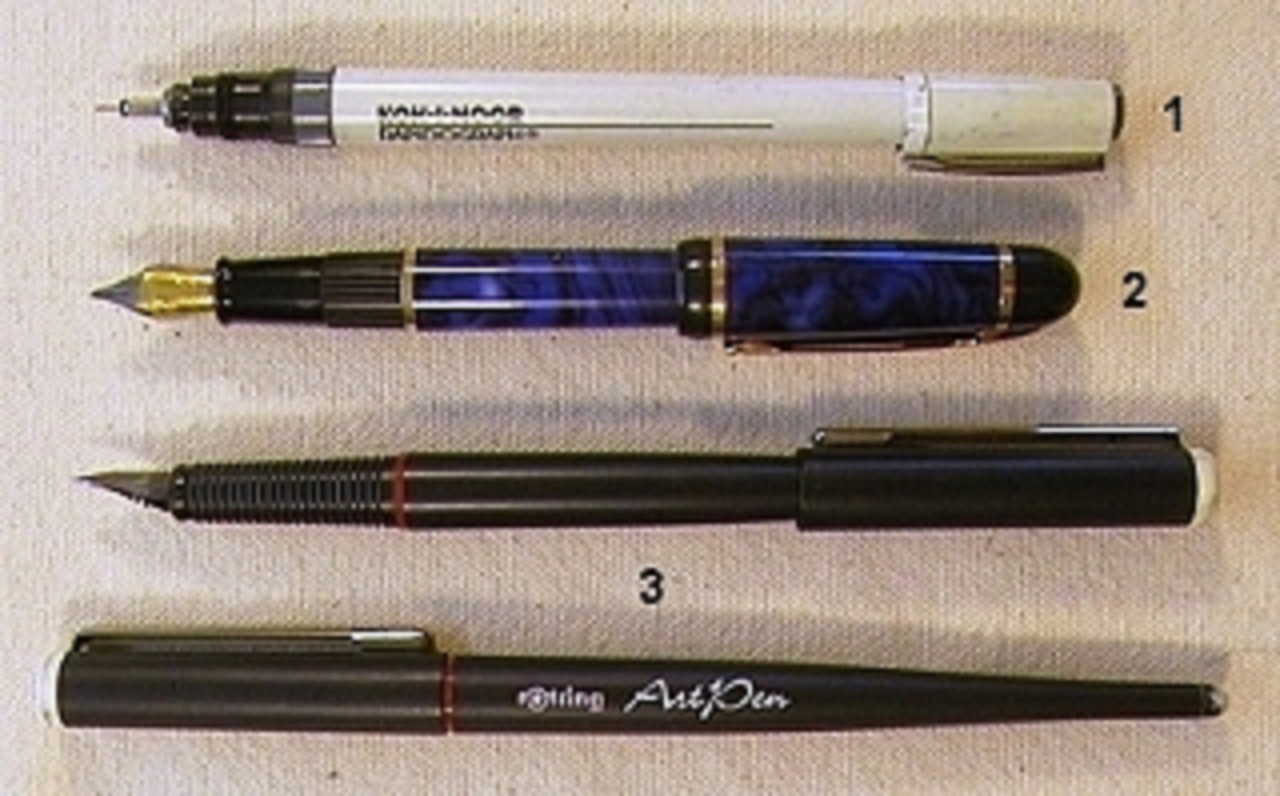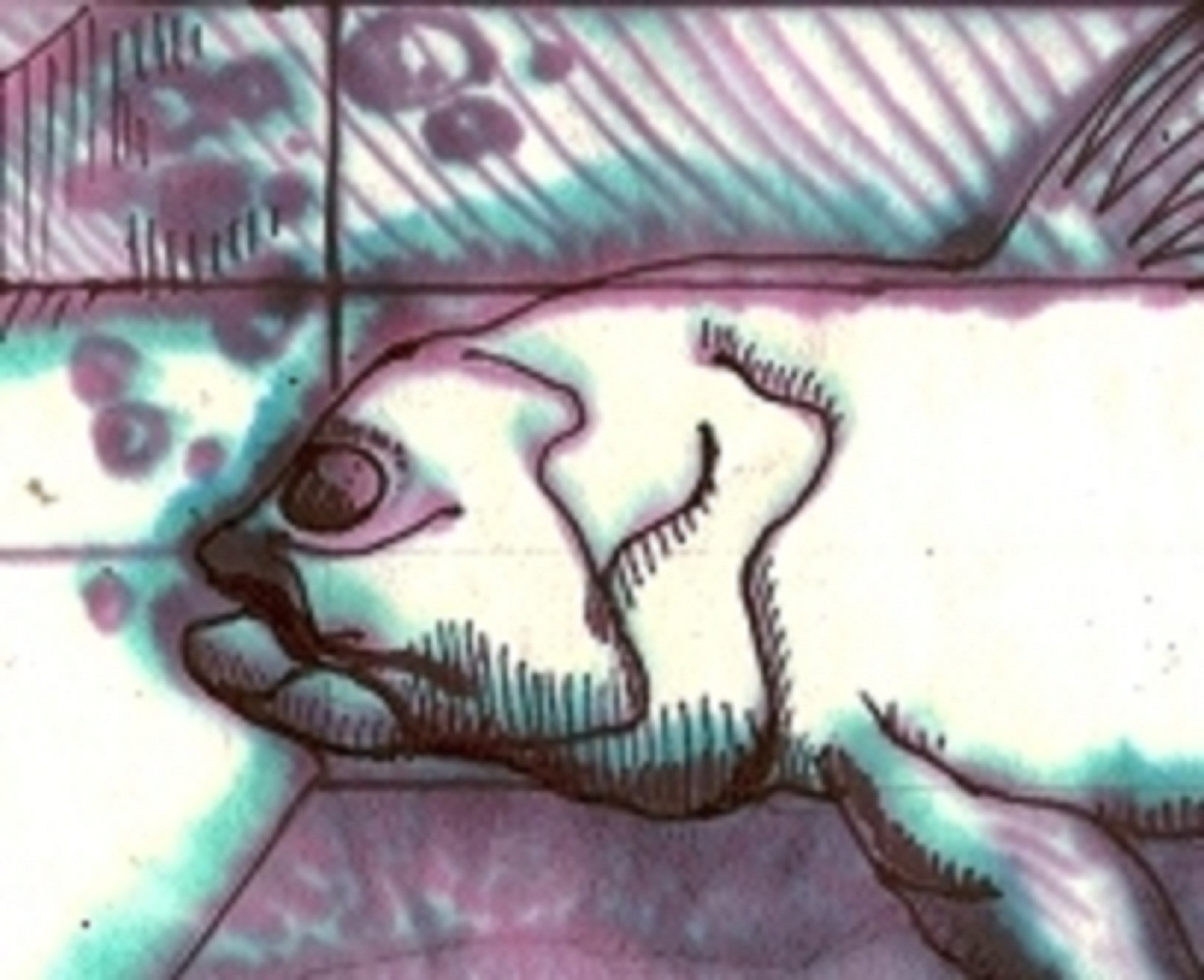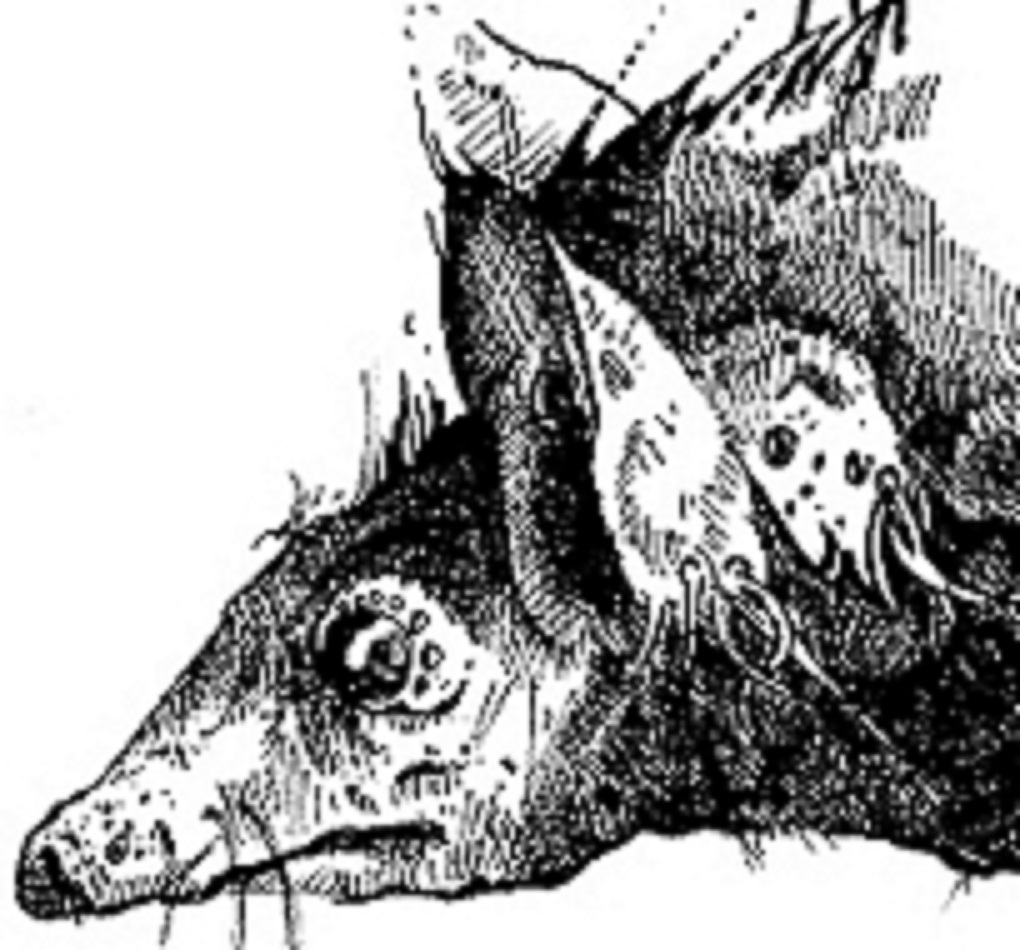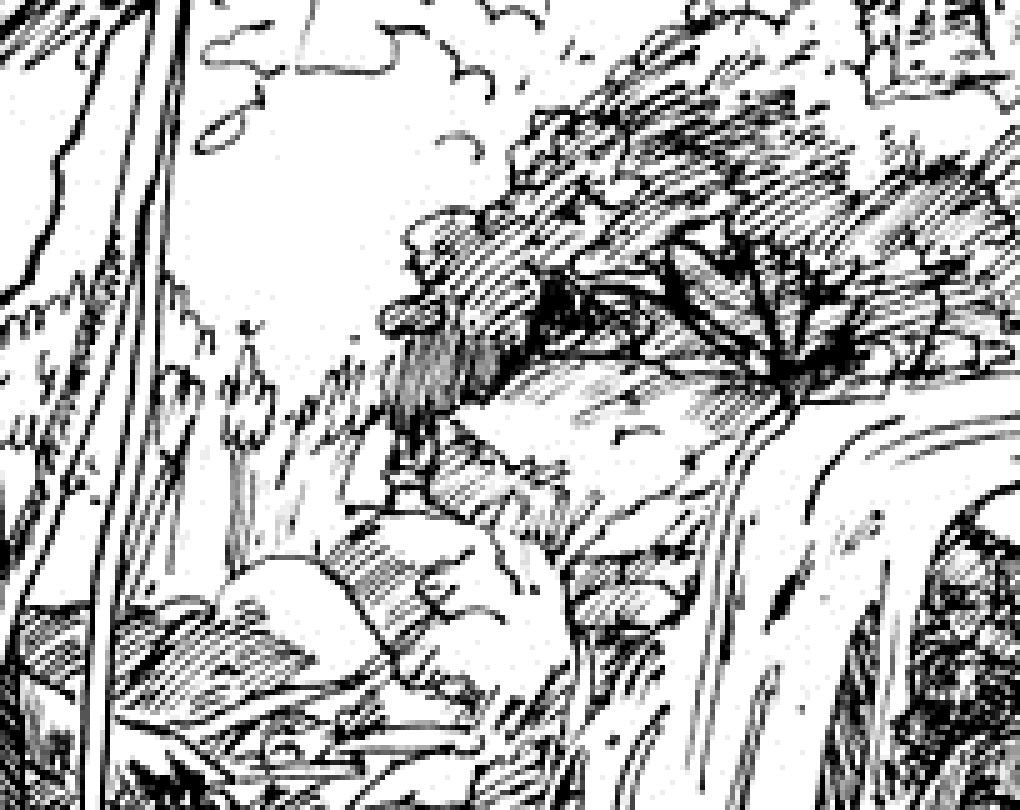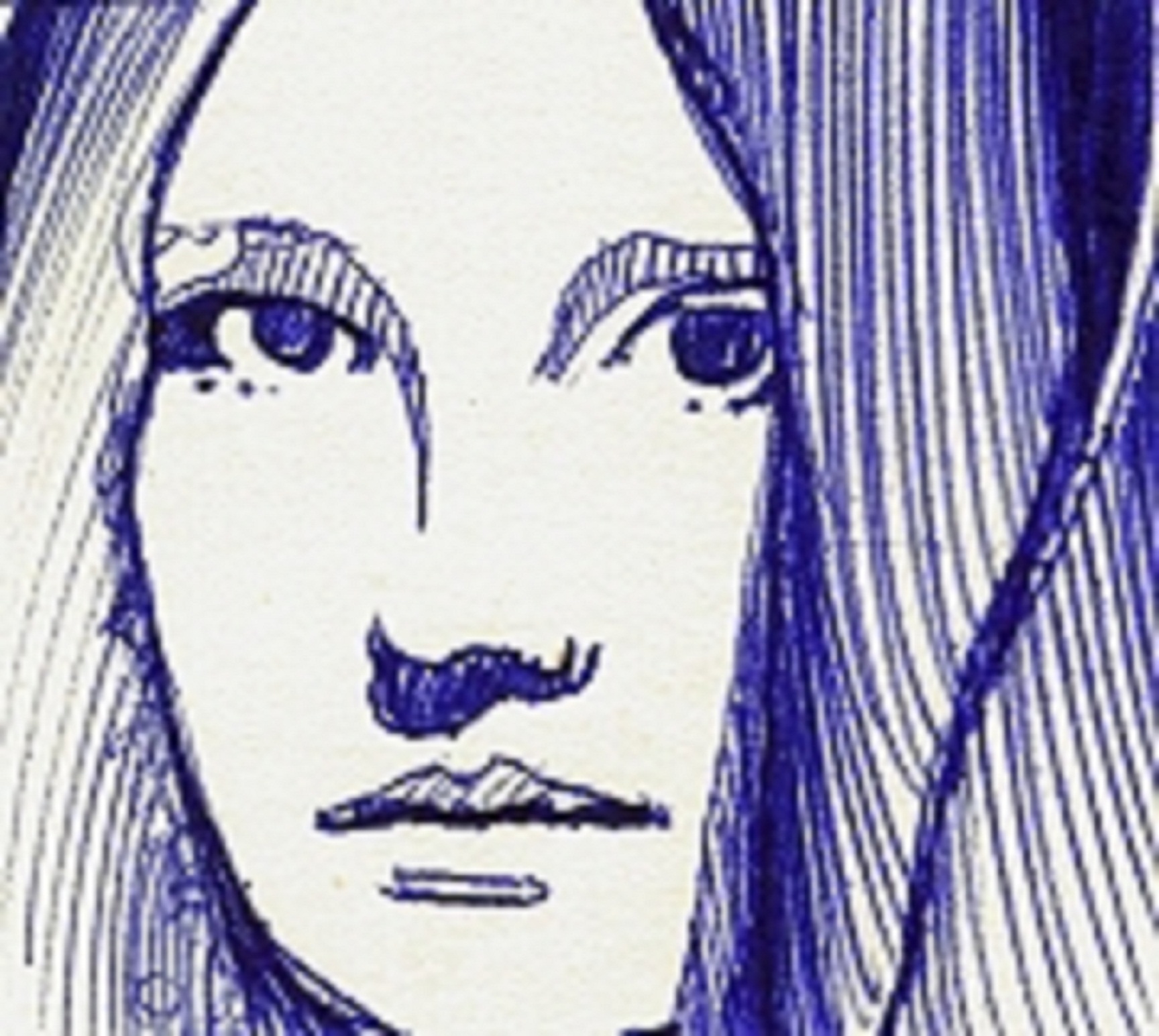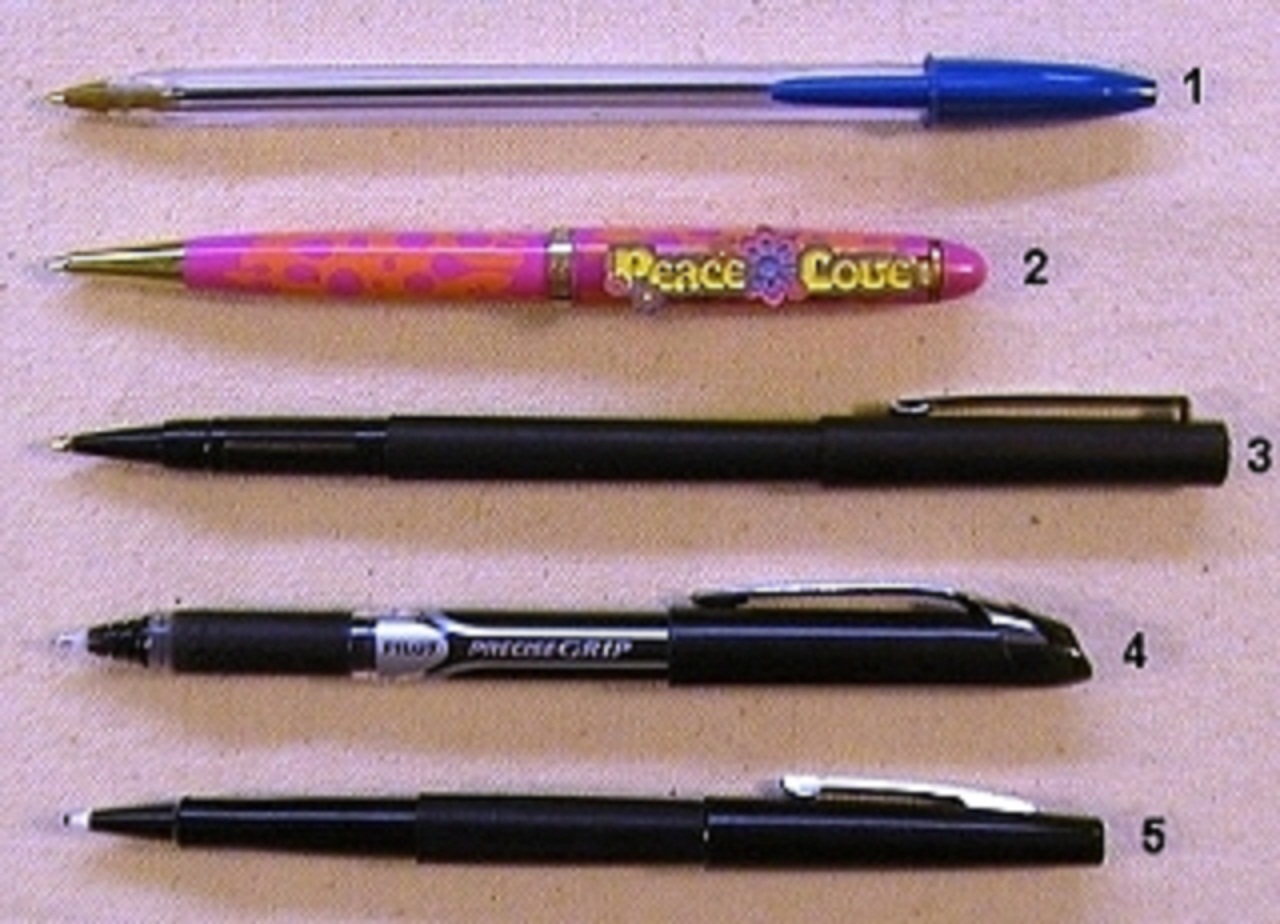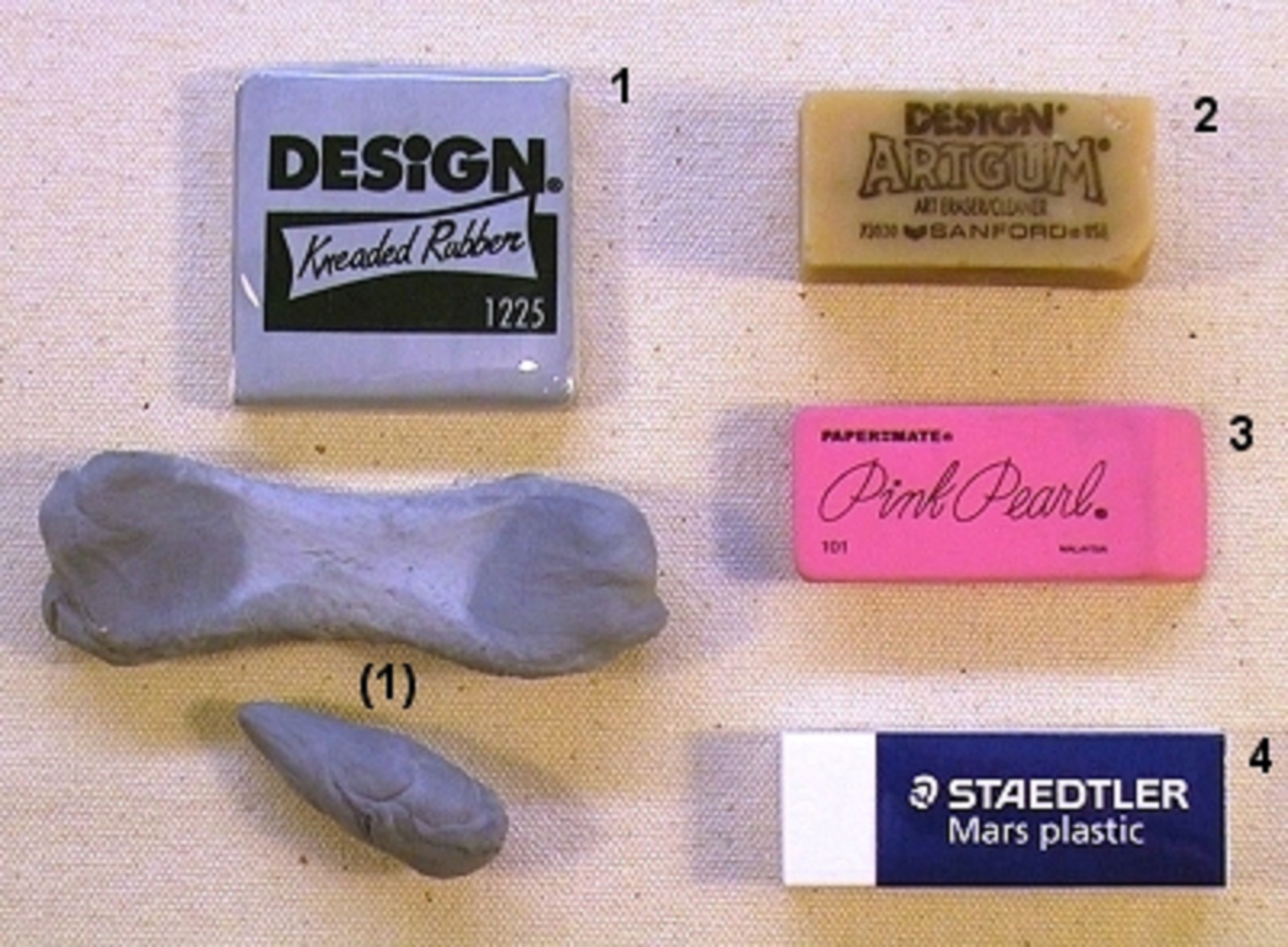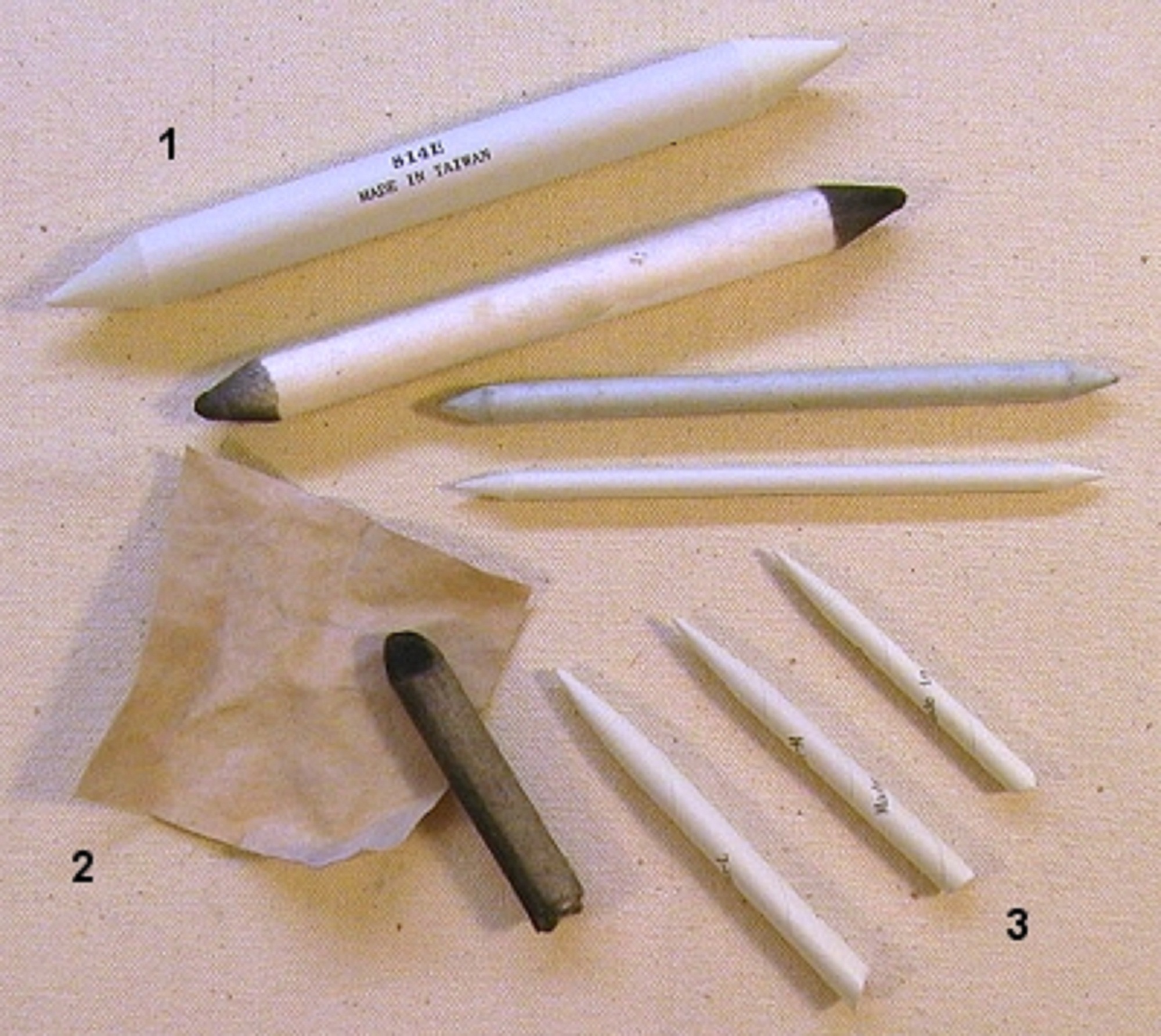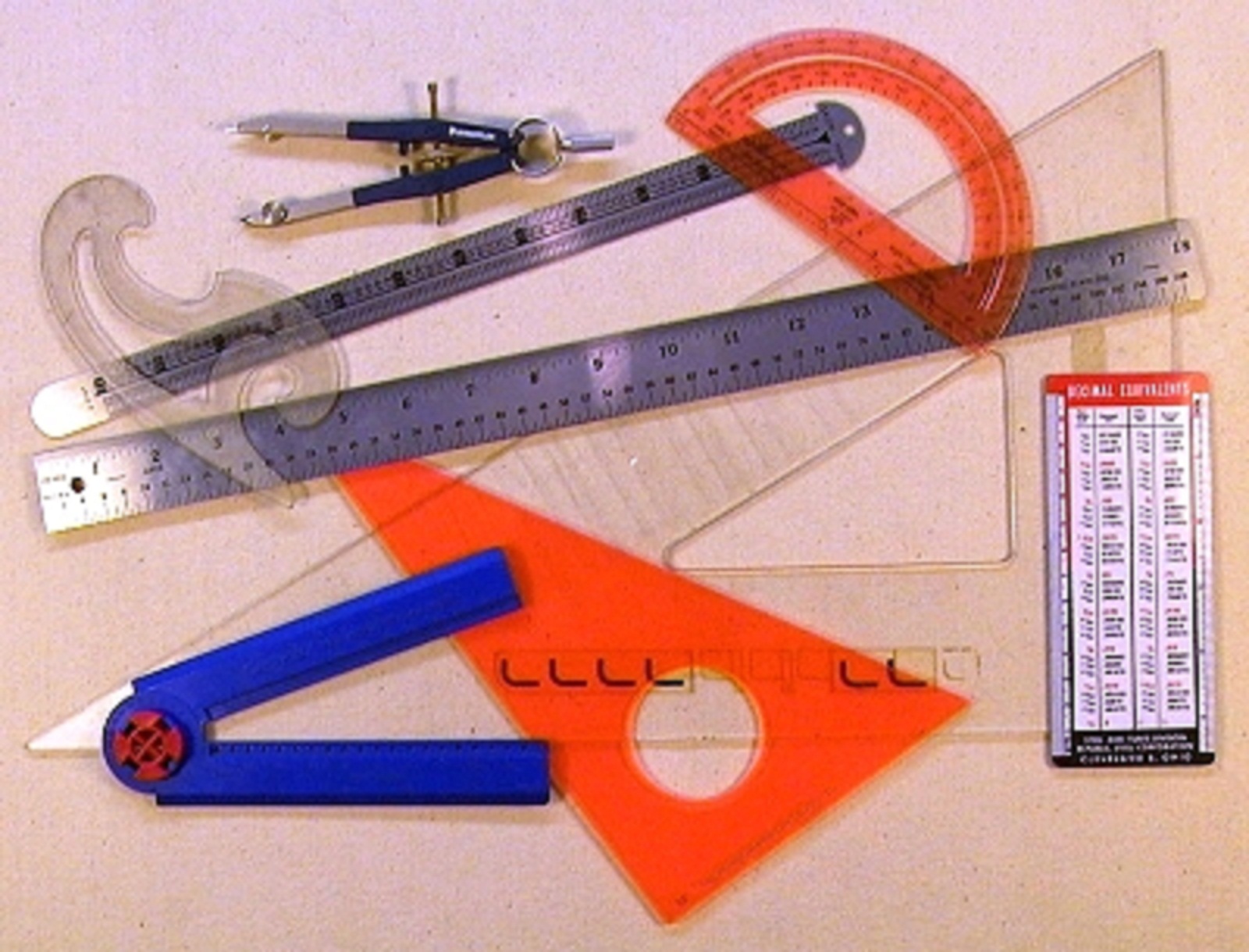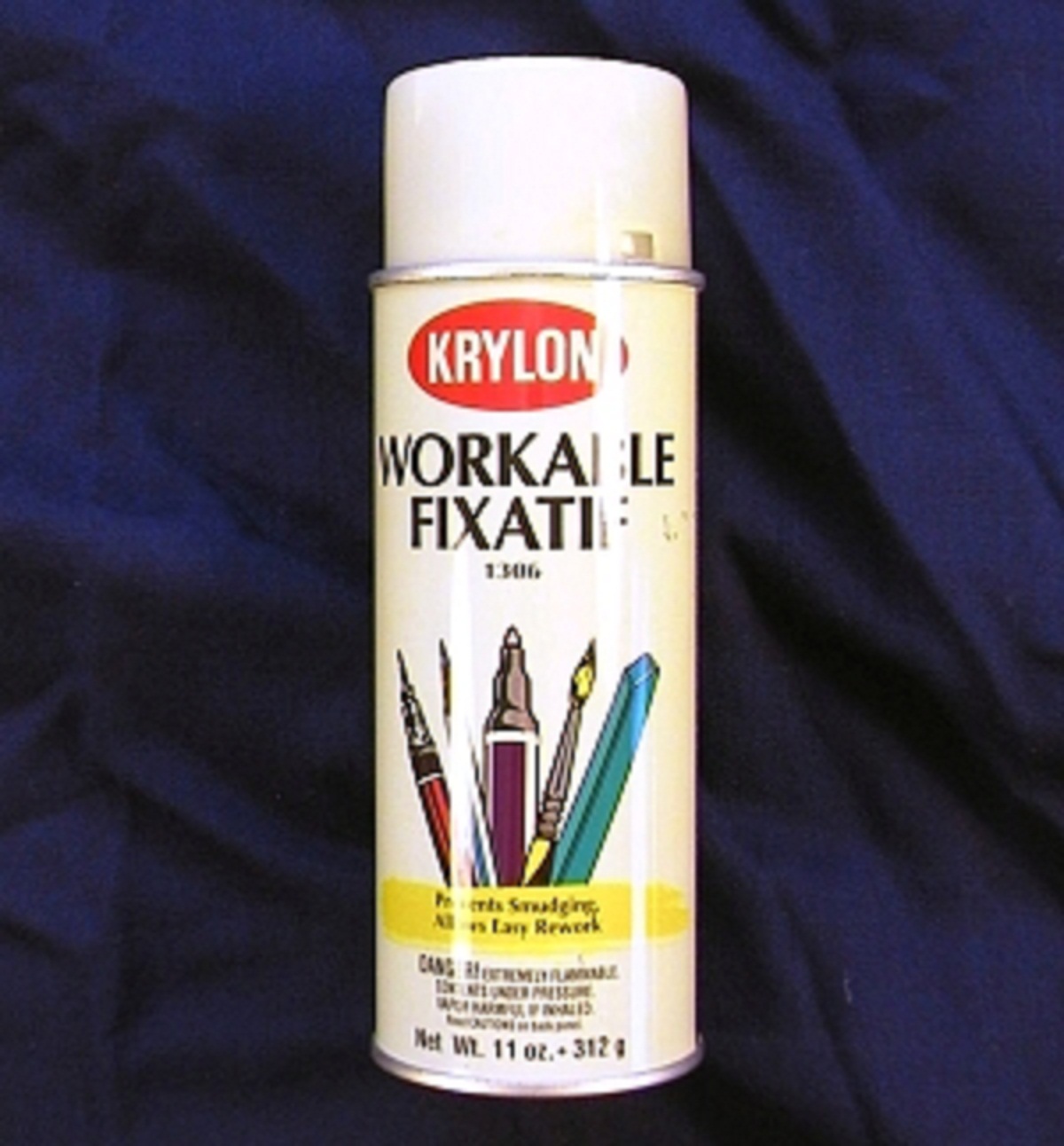Basics of Drawing: Materials
To draw, all you really need is a pencil or pen and a scrap of paper. If you have that, skip this section and start drawing. However, if you don't know a darned thing about drawing materials, what they look like or what they do, or if you need encouragement, understanding, wit, or just like to look at art stuff, read everything on this website. It's free. The choices available in drawing materials are wide and varied. The links at the top of this page offer examples of the conventional drawing media that artists choose to work with. Some drawing media such as pastels, or ink and wash, require much further study in color technique and approach even after you learn to draw well. For any drawing lesson or example, I will generally use graphite pencil on paper unless I am showing the working properties of other media such as charcoal or crayon. It is best to learn to draw with simple pencil and paper. Some of the world's most beautiful and famous artworks are done with pencil and paper. And it's a very cost-effective way to start becoming the artist you intend to be.
"Drawing is the honesty of the art. There is no possibility of cheating. It is either good or bad." —Salvador Dali
Once you gain confidence, you will find yourself trying other drawing materials and techniques. Find those that give the best effect and outlet for your expression. Experiment and play freely while learning the fundamental working qualities of your artistic tools.
Drawing and Sketching Paper
If you want to learn to draw, get yourself a nice spiral- or book-bound sketchpad with lots of pages. If big blank white pages scare you, get a ruled spiral bound notebook and draw over all the little blue lines like you did in study hall. As your confidence increases, you can upgrade your materials as a reward for your efforts!
Spiral-bound Sketchpads
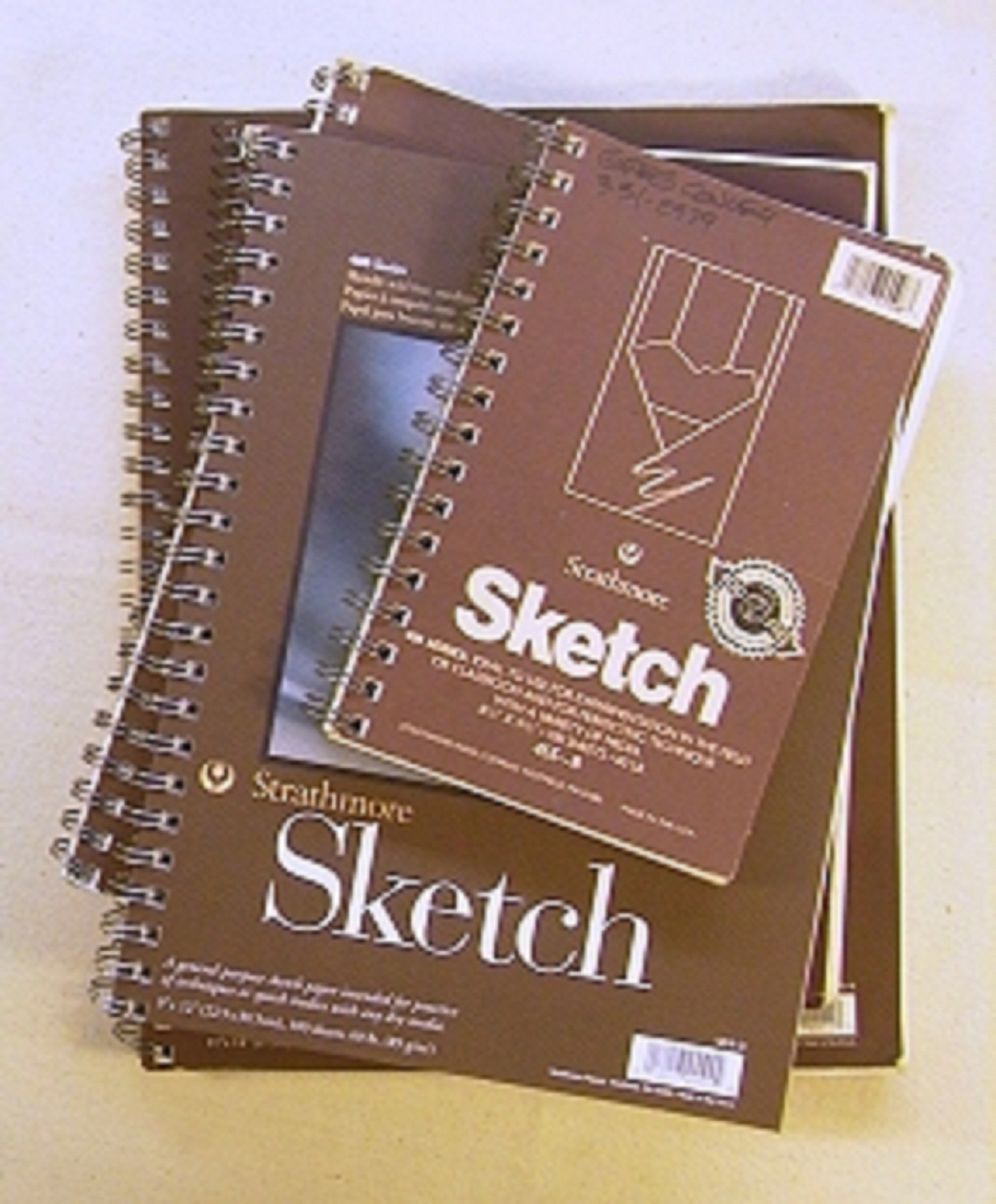 Spiral-bound Sketchbooks Spiral-bound sketchpads are easiest to use because all the pages flip neatly to the back of the pad, leaving you a single flat surface that is easy to hold in one hand for support. The few drawbacks are that with misuse, you can dog-ear the edges of the pad, and unfixed (i.e. drawings that haven't been sprayed with a fixative to prevent smudging) heavy drawings may smudge as the pages flex. Sketchpads have paper that is two or three times heavier than printer paper. Most are designed to be a place for temporary exploration and learning, and are made of stable, but not archival, materials. Archival sketchpads made out of 100% cotton cost a bit more than your regular sketchpad. As well as this particular format being a workhorse item for most artists, they are also the public badges of commitment for art students everywhere.
Spiral-bound Sketchbooks Spiral-bound sketchpads are easiest to use because all the pages flip neatly to the back of the pad, leaving you a single flat surface that is easy to hold in one hand for support. The few drawbacks are that with misuse, you can dog-ear the edges of the pad, and unfixed (i.e. drawings that haven't been sprayed with a fixative to prevent smudging) heavy drawings may smudge as the pages flex. Sketchpads have paper that is two or three times heavier than printer paper. Most are designed to be a place for temporary exploration and learning, and are made of stable, but not archival, materials. Archival sketchpads made out of 100% cotton cost a bit more than your regular sketchpad. As well as this particular format being a workhorse item for most artists, they are also the public badges of commitment for art students everywhere.
Book-bound Sketchpads
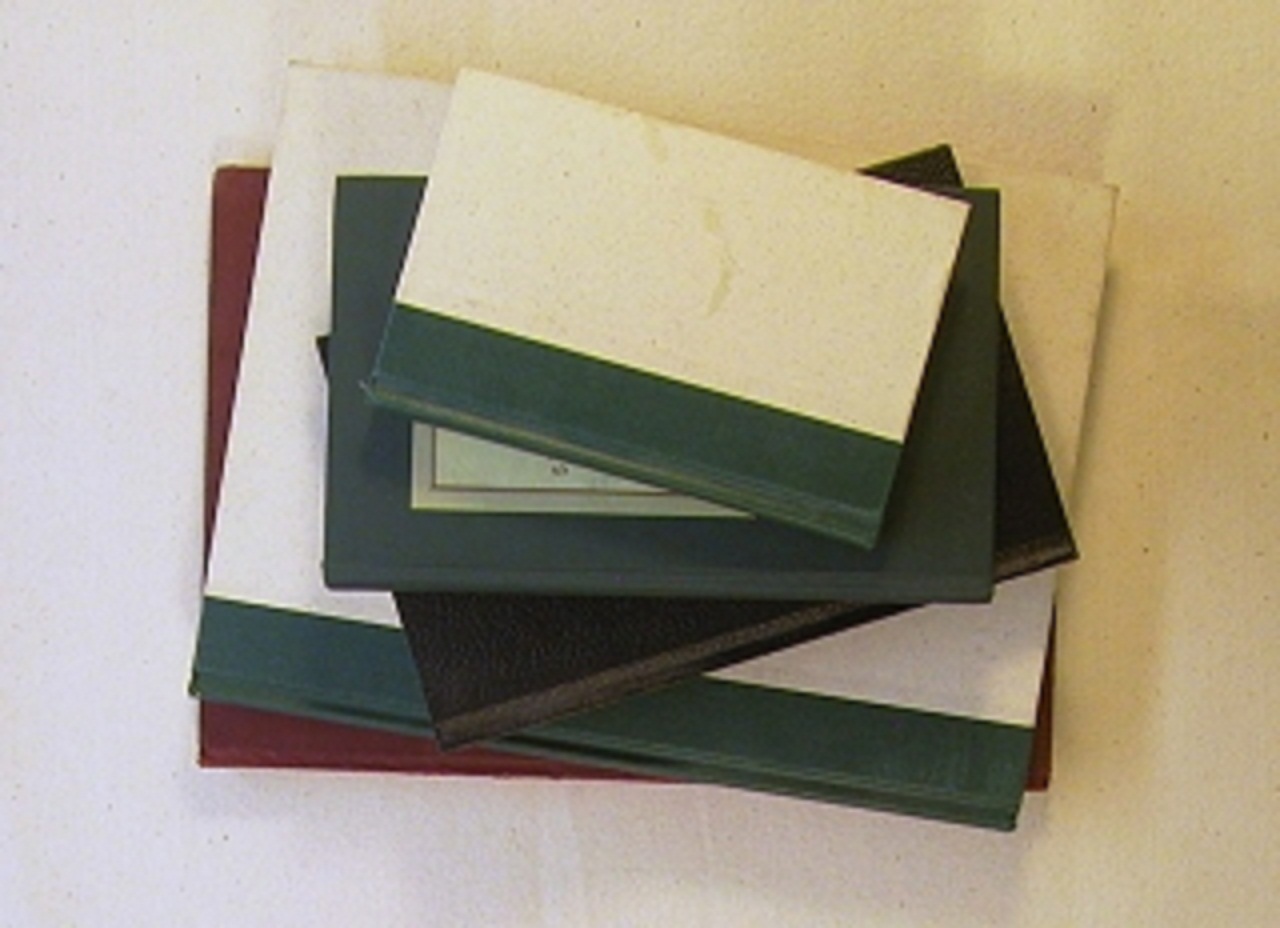 Book-bound Sketchbooks and Journals Sketchbooks that are book-bound like journals are pleasing to look at but are notoriously hard to open flat enough for working without breaking the spine. However, the rigid spine and hard overlapping covers of bound sketchbooks do afford more protection to the drawings inside than a spiral-bound sketchpad. Make sure that a book-bound sketchbook opens easily and the paper is pleasing to your tastes before you buy it! I've encountered one problem with buying a beautifully bound journal - drawing that first sketch. I've had a couple of very nice sketchbooks right here in my studio for over a year. When an idea needs sketching my first inclination is to grab one of my Strathmore pads. ...Maybe it's just me.
Book-bound Sketchbooks and Journals Sketchbooks that are book-bound like journals are pleasing to look at but are notoriously hard to open flat enough for working without breaking the spine. However, the rigid spine and hard overlapping covers of bound sketchbooks do afford more protection to the drawings inside than a spiral-bound sketchpad. Make sure that a book-bound sketchbook opens easily and the paper is pleasing to your tastes before you buy it! I've encountered one problem with buying a beautifully bound journal - drawing that first sketch. I've had a couple of very nice sketchbooks right here in my studio for over a year. When an idea needs sketching my first inclination is to grab one of my Strathmore pads. ...Maybe it's just me.
Better Paper and Other Considerations
If you're confident in your skills, work on archival quality 100% cotton drawing papers using fine artist's pencils. If you're just starting out or need to save money, use a pad of manilla paper and a big black crayon. It doesn't matter what you use to draw on, just don't make it hard to do what you're trying to do. Most sketchbooks are intended for temporary drawings, so after a few decades the edges of the paper will likely yellow from the outside in. Although modern paper is usually not acidic, the materials in the paper are not truly archival in the long haul. They are intended for fleshing out ideas while experimenting with subject matter and technique. For more serious work use the heavier weight acid-free papers found in drawing pads, Bristol board pads, watercolor papers, or illustration boards. These papers are often available in larger dimensions, too. For doing your largest drawings, you can use single sheet drawing or printmaking papers in sizes ranging from 18" x 24" to 30" x 40", or if you want to go really big, purchase large rolls of paper 42" or more in width and over 30' (10 yards) wide. In any case, you'll need something to draw on.
Sketching on the Run
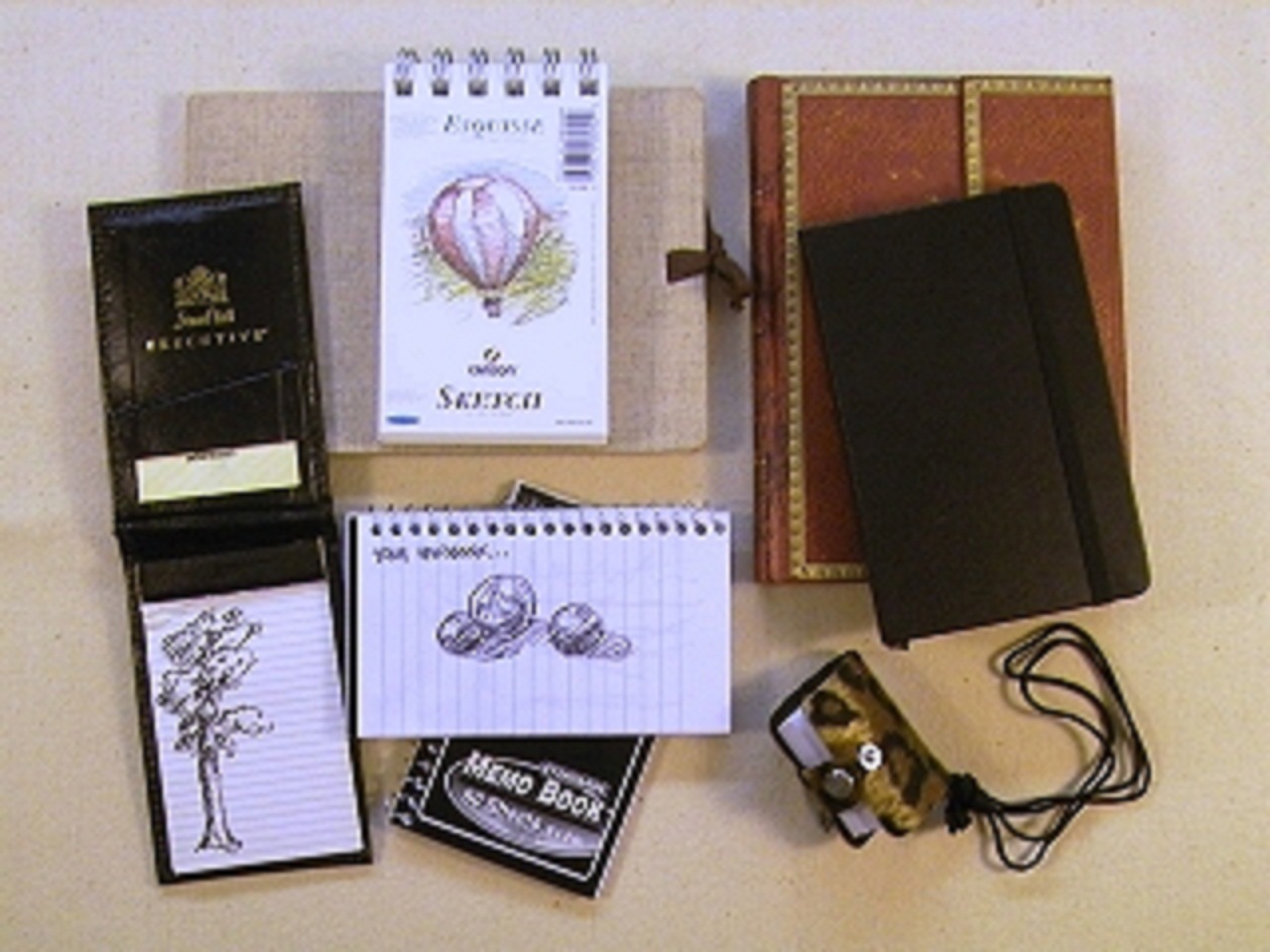 Pocket-sized, Moleskine and Novelty On the left you'll see an assortment of small, pocket sized sketchpads. From 49¢ pocket memo pads to the $12.00 Moleskine classic journals, you can find something you can afford easily if you keep your eyes open while shopping. The 97¢ faux fur necklace sketchpad you see in this picture was just too stupid not to buy. The next time you stop at your local stationery or drug store, walk down the school supply aisle and grab yourself a sketchpad. Now turn around. See any interesting marking devices to go with that pad? Recommended brands (if the generic ones don't cut it for you): Strathmore, Canson, Fabriano, Bienfang, Hahnemühle, Stonehenge, Utrecht, Watson-Guptill, Winsor & Newton, Moleskine, Blick.
Pocket-sized, Moleskine and Novelty On the left you'll see an assortment of small, pocket sized sketchpads. From 49¢ pocket memo pads to the $12.00 Moleskine classic journals, you can find something you can afford easily if you keep your eyes open while shopping. The 97¢ faux fur necklace sketchpad you see in this picture was just too stupid not to buy. The next time you stop at your local stationery or drug store, walk down the school supply aisle and grab yourself a sketchpad. Now turn around. See any interesting marking devices to go with that pad? Recommended brands (if the generic ones don't cut it for you): Strathmore, Canson, Fabriano, Bienfang, Hahnemühle, Stonehenge, Utrecht, Watson-Guptill, Winsor & Newton, Moleskine, Blick.
Drawing Materials: Graphite Pencils
Choose Your Fave
You can't beat the classic Eberhard Faber Ebony pencil or a softer leaded (grade #1) classic yellow pencil by Sanford or Dixon. They're very responsive and smooth on paper. Artist grade 4B pencils are also a popular choice. All of these are soft leaded and smudge easily but offer great tonal range. Standard #2 pencils laying around your house will do in a pinch but they vary widely in quality and depth of value (i.e. how light or dark of a mark you can get). Test each pencil you happen to come across on your paper to see how it feels. Use the one that feels the most responsive to your touch. For beginners I recommend an EF Ebony pencil #6325 and a good pencil sharpener. Working with a soft dark pencil forces you to loosen up and commit at the same time. I've used Ebony pencils from high school through art school and until this day! A mainstay for most artists, Ebony pencils are of consistent high quality and responsiveness. Pencils pictured above:
1) Ebony Pencil by Eberhard Faber 2) Sanford Mirado #1/B 3) Dixon Ticonderoga #1/B 4) Sanford Design 1B 5) Sanford Design 2B6) Sanford Design 4B 7) American Pencil Venus 5B 8) Bic Velocity 0.9mm disposable 9) KOH-I-NOOR Rapidomatic 0.7mm (B) 10) Bic #2 0.7mm lead disposable
The marks they make
 The marks of different pencils vary with the size, shape, and composition of the lead. Pencils 1, 3, 7, and 10 produced the darkest blacks.
The marks of different pencils vary with the size, shape, and composition of the lead. Pencils 1, 3, 7, and 10 produced the darkest blacks.
Pencil Grades
The softness of graphite artist's products are rated alphanumerically around this basic scale: (Most Soft) 8B, 7B, 6B, 5B, 4B, 3B, 2B, B, HB, F, H, 2H, 4H, 6H, 8H (Very Hard) B = Blackness, H = Hardness, HB = Std. #2, F = Fine Point (Std. #3-4) The pencil grades most often used by artists are marked in bold. These are the softer grades that are more responsive to your touch on paper. Hard grades will give a silky light gray finish that can resemble silverpoint drawing. Graphite is a form of crystallized carbon. So are diamonds for that matter! But graphite by nature is very soft and greasy, and flakes easily. This allows it to be pushed into the fiber (a.k.a. "tooth") of the paper you're drawing on. Harder graphite pencils require more clay and additives in their formulation for added firmness. The addition of hardening agents shortens a pencil's available tonal scale. With the same amount of pressure the hardest grades can only achieve a light gray while softest grades achieve deep blacks. FYI: Fine graphite powder is used as a mechanical lubricant. When formed and fired, graphite and clay are used for crucibles to smelt molten metals. Once mixed with different clays, you get pencils.
Lead and Silver
Metallic lead, the poisonous one, has much of the same properties as graphite and slivers or rods of lead have been used for drawing since ancient times. After its discovery in the 18th century, graphite was found to be superior to lead as a drawing medium. Its Greek name meaning "to write or draw," pieces of graphite were held in wooden or metal clutches like chalks. New formulations in the 19th century allowed the wood-encased graphite pencil to become widely available. Silver has been used as a drawing tool for centuries. Pure silver leaves a light gray patina like a hard pencil on the paper. The light gray silverpoint values will darken with time as the silver tarnishes from gray to black. Gold will also leave a unique mark on paper but it does not tarnish like silver. FYI: To try this historic medium, pop some jeweller's silver wire in a mechanical clutch lead holder and shape the point on sandpaper. Burnish the tip on scrap paper before you draw.
Solid Graphite - Sticks
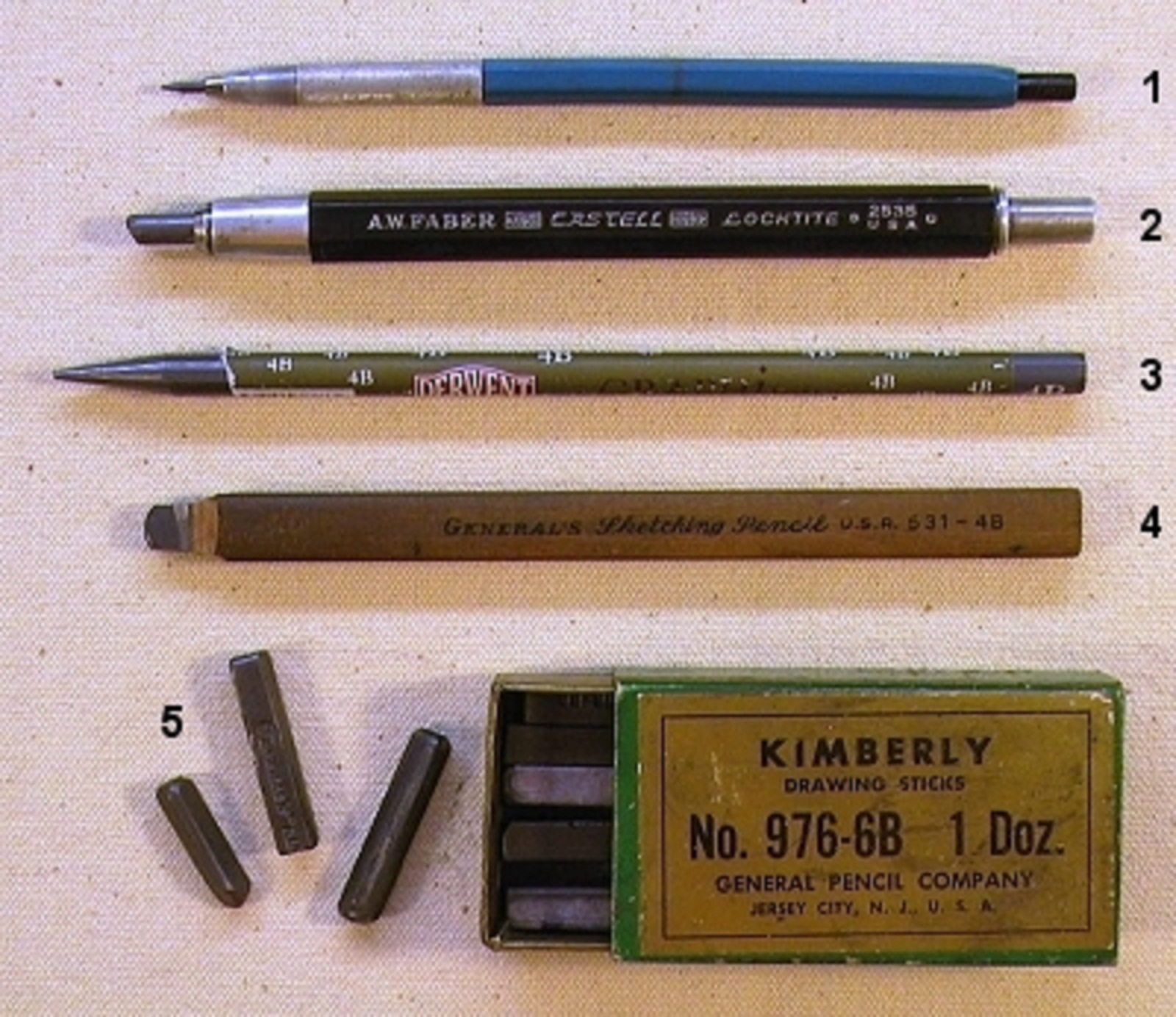 As the graphite choices get thicker they move from leads for mechanical clutch holders to solid rods or sticks for broad sweeping strokes. Pictured above are several thicker graphite examples I had laying around the studio, plus one I bought for the occasion. You can see their results on paper pictured below the photo. I've found the large lead clutch and General's sketching pencil the most useful for drawing and sketching purposes. I've used the graphite sticks primarily for creating carbon transfers of drawings to watercolor paper. Solid graphite sticks are a quick and inexpensive way of creating chemically inert transfer papers.
As the graphite choices get thicker they move from leads for mechanical clutch holders to solid rods or sticks for broad sweeping strokes. Pictured above are several thicker graphite examples I had laying around the studio, plus one I bought for the occasion. You can see their results on paper pictured below the photo. I've found the large lead clutch and General's sketching pencil the most useful for drawing and sketching purposes. I've used the graphite sticks primarily for creating carbon transfers of drawings to watercolor paper. Solid graphite sticks are a quick and inexpensive way of creating chemically inert transfer papers.
Bigger leads equal bigger marks
1) Berol Turquoise lead holder, 1/16" 2B lead 2) 3/16" 4B lead in an A.W. FABER-CASTELL Locktite 2535 3) Derwent Graphitone solid 4B pencil 1/4" dia. 4) General Pencil Company's 4B Sketching Pencil, 3/8" x 1/8" lead, aka "Carpenter's pencil" 5) General Pencil Company's Kimberly 6B graphite sticks 1/4" x 1/4" x 3".
Recommended brands: General Pencil Company, Derwent, Eberhard Faber, Faber-Castell Goldfaber, Dixon, Berol (Sanford), Sanford DESIGN (formerly Venus), Staedtler, Cretacolor.
Drawing Materials: Charcoal
Endorsed by Cavemen Everywhere
Charcoal is used for its bold deep blacks and softly feathered grays achieved through smudging the soft medium across the paper. Apparently it worked well on prehistoric cave walls too. Fingers, tortillons, stumps, chamois, and soft brushes are used for controlled blending and shaping of grays. Erasers can reclaim lighter tones and define sharp highlights. Natural vine charcoal makes a rich gray line, and lighter grades can be easily rubbed off with a soft rag. Natural willow charcoal is harder than vine charcoal and produces a denser black line.
Charcoal Samples:
1) Natural Vine Charcoal 2) Natural Willow Charcoal 3) Compressed Charcoal Stick 4) Skylight Studio Peelable Hard 5) Berol Peelable Extra Soft 6) General Charcoal Pencil 4B 7) Eagle Charco Pencil 4B 8) L. & C. Hardmuth Carbon Pencil No. 5
Very soft vine charcoals are often used as a temporary medium for drawing on paper or canvas when starting a painting. The sketched image must be sprayed with fixative before painting begins. Both vine and willow charcoals are suitable for complete drawings. Loose painterly effects are easily achieved with these very soft natural charcoals. Compressed charcoal in the form of solid sticks, wood-encased pencils, and peel-as-you-go paper wrapped pencils are readily available at craft or art supply outlets. Charcoal formulations, including vine charcoal, range from extra soft to hard. The grade of natural charcoals depends on the density of the wood used to make it. Vine charcoal has traditionally been made with grape vine wood. And willow, well, there you go. Carbon pencils are made with lampblack (oil soot) which is a very black form of carbon. They are graded for softness the same as graphite pencils and wood encased charcoal pencils. Recommended brands: Winsor & Newton, Derwent, General, Wolff's Carbon, Prismacolor, Alphacolor, Conte, Yarka.
Drawing Materials: Chalks, Conte, and Pastel
Like Fingernails on a Blackboard...
Your first contact with chalk may have come in the form of writing on a chalkboard or drawing on construction paper. Even before that you may have drawn on your driveway or sidewalk. Ever play hopscotch? When you didn't have chalk you knew to grab a soft light-colored stone to draw your line with. Some didn't work but some did. There's a lot of "tooth" on a sidewalk and it takes rocks well. If you found a bit of an old brick you could make some red lines because of the color of the clay used. Artists have been using natural earth colors made from clays and minerals since the dawn of art. But leave it to a Frenchman...
Chalk Samples:
1) Blackboard Chalk (CaCO3) 2) Conté Sticks - various colors 3) #5 Black Conté Solid 4) #3 Black Conté Pencil 5) Conté White Pencil 6) Conté Sepia Pencil 7) Gray Pastels - warm 8) Pastels - various basic colors
Conté Crayons and Pencils
Brand named artist drawing products have been around since the 18th century when French scientist Nicolas-Jacques Conté invented a new formula for a graphite and clay based pencil encased in wood. Conté expanded available colors by using various natural clays and other ingredients. Artists can thank Conté for the classic "artist's" chalks. Available in stick or pencil form, the Sanguine (Blood) or red Conté is the most recognizably used Conté color. Basic Conté chalks come in earthy natural shades of reds and browns, as well as grades of black and white. Like pastels, Conté chalks come in a full spectrum of colors.
Blackboard Chalk (CaCO3)
Standard blackboard chalk is made of soft, powdery limestone fossil rock consisting of millions of hexagonal fossils of coccoliths, a certain type of marine plankton. The softness of chalk varies and you must use a light fixative to prevent smudging, as with charcoal.
More Black, Whites, Grays
You can purchase grayscale pastel sets for quick outdoor sketching or more studied value work in the studio. Most prepackaged sets contain 8 to 16 values from black to white. If you want to get past the colors and right to selecting the underlying values of a subject, you might find this medium an interesting change of pace. You must use a few light coats of fixative if used in a sketchbook. Otherwise you'll end up with a gray mush.
Pastels
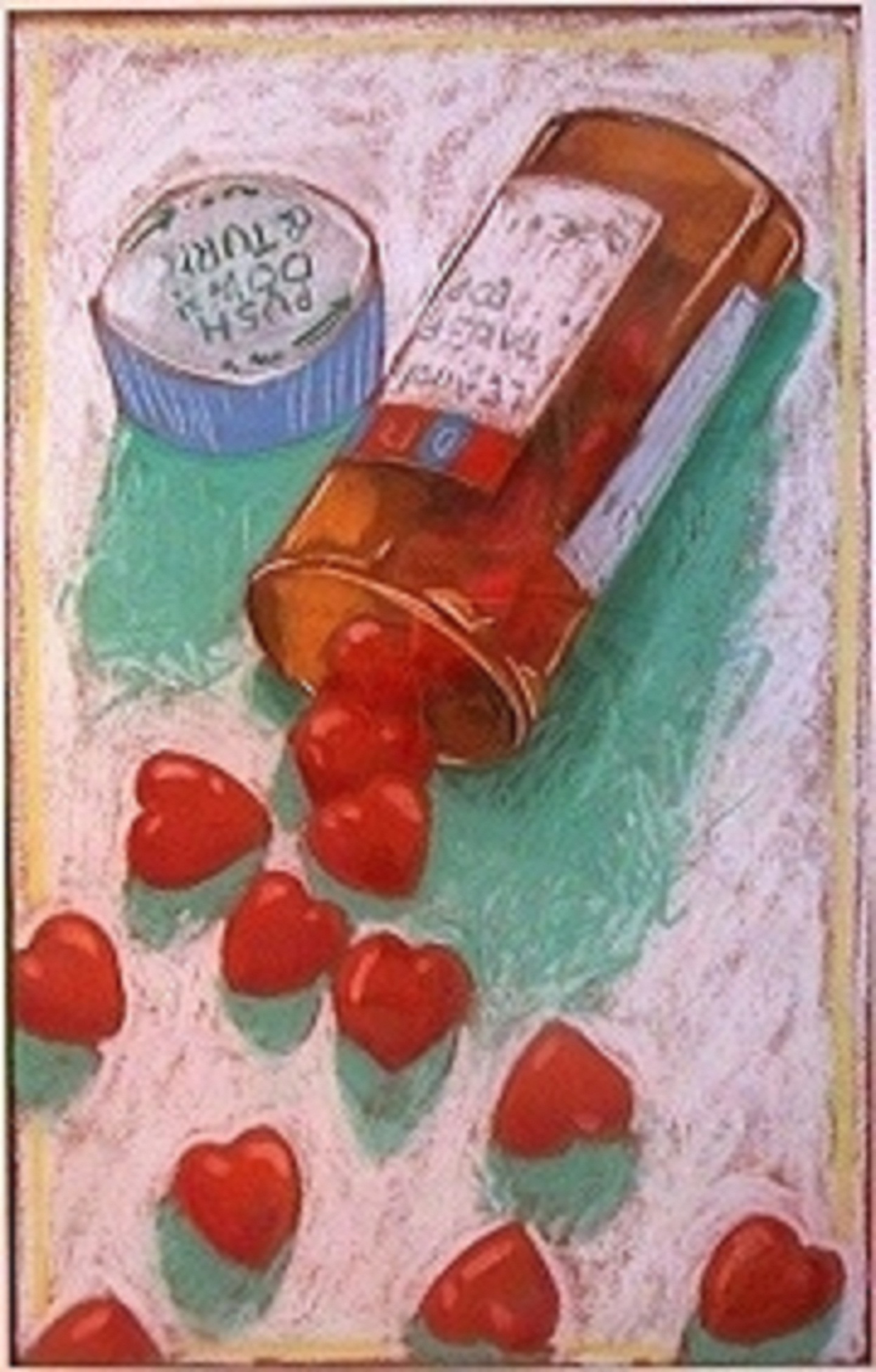 For quick drawing in color, pastels are the most immediately satisfying medium you can use. They take to paper quickly and are easily manipulated and blended. Pastel pencils are suggested for basic drawing and sketching. Pastels are not actually chalks per se; they're prepared from a paste made of pigments, fillers, and gum arabic, which is formed to shape and thoroughly dried. Full and half sized sticks are rolled into small cylinders or formed into sticks. Pastel paper has a fine tooth or weave specifically developed for pastel and charcoal and is available in a wide variety colors and tints. You can use a light fixative during the drawing of, and after the completion of a pastel drawing. Warning: Having a few different colors of pastel on hand can lead to a full-blown pastel painting! Recommended brands: Sennelier, Conte, Cretacolor, Derwent, Dawler-Rowney, Faber-Castell, Reeves, Rembrandt, Sargent Art, Schwan-Stabilo, Van Gogh, Winsor & Newton.
For quick drawing in color, pastels are the most immediately satisfying medium you can use. They take to paper quickly and are easily manipulated and blended. Pastel pencils are suggested for basic drawing and sketching. Pastels are not actually chalks per se; they're prepared from a paste made of pigments, fillers, and gum arabic, which is formed to shape and thoroughly dried. Full and half sized sticks are rolled into small cylinders or formed into sticks. Pastel paper has a fine tooth or weave specifically developed for pastel and charcoal and is available in a wide variety colors and tints. You can use a light fixative during the drawing of, and after the completion of a pastel drawing. Warning: Having a few different colors of pastel on hand can lead to a full-blown pastel painting! Recommended brands: Sennelier, Conte, Cretacolor, Derwent, Dawler-Rowney, Faber-Castell, Reeves, Rembrandt, Sargent Art, Schwan-Stabilo, Van Gogh, Winsor & Newton.
Crayons and Colored Pencils
Colored Pencils (1)
Colored pencils are a mixture of wax, pigment, fillers, and additives. The popular Prismacolor variety by Berol (Sanford) are rich in color density and come in a wide variety of colors. They behave much like dense wax crayons when used heavily and like pencils when used for general drawing or sketching. Prismacolor pencils blend easily and you can glaze colors over top of each other. Some Professional Artist's colored pencils are lightfast rated in grades I and II according to ASTM (American Society for Testing and Materials) D6901 Standard Specification for Artists’ Colored Pencils.
The Marks They Make:
1) Berol Prismacolor Pencils 2) Wm. Korn Lithographic Pencil 3) Wm. Korn Lithographic Crayon 4) Crayola Crayons 5) Berol Prismacolor sticks
Lithographic Crayons (2,3)
Created for drawing on lithographic stones or plates, grease-laden lithographic crayons (sticks) or pencils (paper-wrapped) can create rich blacks and velvety darks grays on smooth paper. FYI: The warmth of your hand will soften the lithographic crayon and make it sticky.
Wax Crayons (4)
Traditional (Crayola style) wax crayons are excellent for no-holds-barred scribblefests on a pad of manila paper or a stack of printer paper. Best displayed with magnets on enamelled appliances.
Colored Pencil Sticks (5)
Harder formulated wax based sticks like those by Prismacolor can give bold broad strokes. They are essentially large sticks of colored pencil leads.
Watercolor Pencils (A)
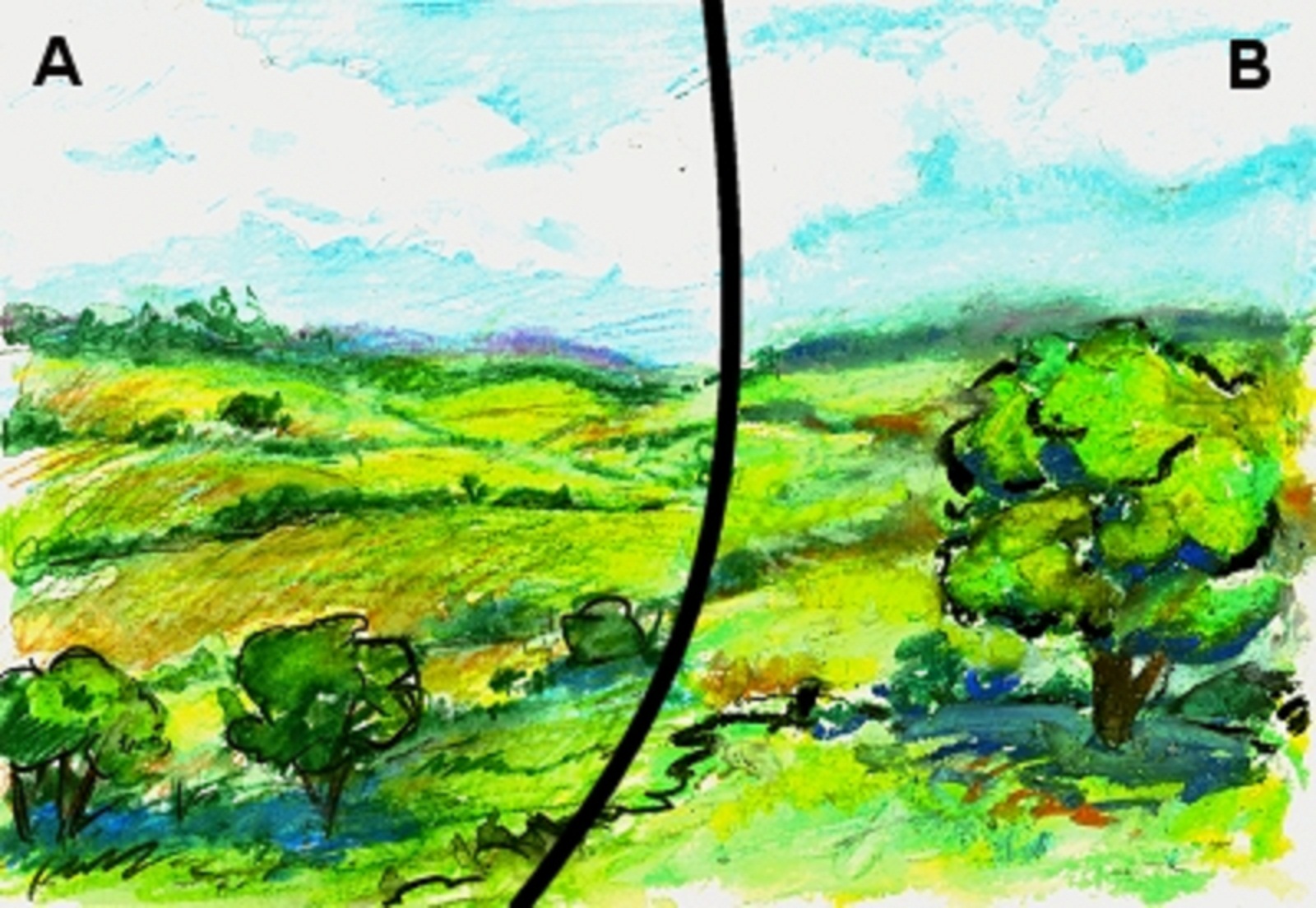 Watercolor pencils require a cross-over painting technique that is not covered here but go for it if that's what you have on hand. After drawing and coloring, you then paint with clear water and the colors dissolve into watercolors. You can draw over wet areas for bolder lines. Use heavier watercolor paper to draw on, at least 140lb weight if you will be using a lot of water. Check for lightfastness before choosing a set.
Watercolor pencils require a cross-over painting technique that is not covered here but go for it if that's what you have on hand. After drawing and coloring, you then paint with clear water and the colors dissolve into watercolors. You can draw over wet areas for bolder lines. Use heavier watercolor paper to draw on, at least 140lb weight if you will be using a lot of water. Check for lightfastness before choosing a set.
Oil Pastels (B)
Oil pastels are dense, soft, waxy paint sticks used primarily for loose color sketching and drawing. They are a cross between encaustic (wax paint) and crayons, with oil and other conditioners in their formula. Oil pastels can be blended easily using a brush and mineral spirits or turpentine. Oil pastels should not be mixed with other media like oil paint, encaustic or acrylic. Professional grades are rated for lightfastness. Recommended brands: Berol Prismacolor, Derwent, Crayola, Faber-Castell, Holbein, Sennelier, Caran D'Ache.
Drawing Materials: Markers
Didn't That Pink Use to be Red?
Art markers are designed for use by illustrators and graphic artists in situations where immediate impact outweighs the need for total archival quality. Markers were not designed for the lasting needs of fine artists. The dyes used are brilliant but can fade rapidly upon exposure to sunlight. This makes them ideal for their intended use, creating art for immediate reproduction.
Marker Marks:
1) Designer's markers, broad/fine 2) Fine, medium "Permanent" markers 3) Black, 40% gray & 70% gray
Markers and How They Work
Markers are fiber-tipped pens that work by capillary action as the dye is "sucked" from the fiber holding tank inside the barrel of the pen. With widths from very fine to very broad to the brush tip, the typical "permanent" marker has a chiseled broad nib on one end and a fine or very fine nib on the other end. Using the term "Permanent markers" is deceptive. It only means the dyes are waterproof but they may fade in time. Lightfast and pigmented markers are available in limited color ranges. Check the label for lightfast rating, and whether the marker's ink is alcohol-based or water-based. Markers are great for quick color studies to test your ideas before you flesh them out in a more permanent medium like watercolor, acrylic, or oil paints.
Value Sketching
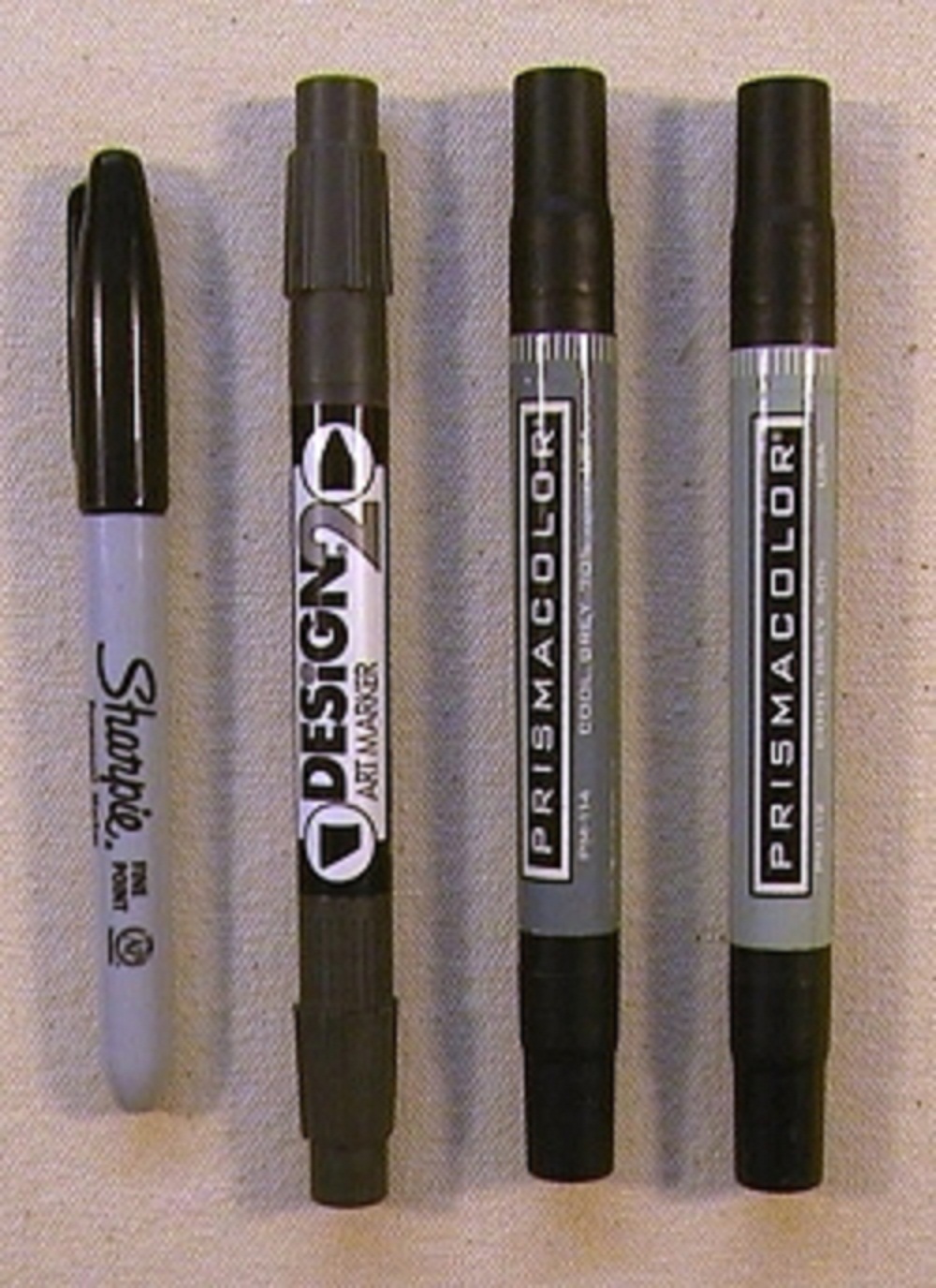 For basic sketching, I would recommend Sharpies and design markers in black, and two distinct grays in the 20% to 70% gray range. For color work there are prepackaged sets available for general drawing, landscapes, portraits, etc.
For basic sketching, I would recommend Sharpies and design markers in black, and two distinct grays in the 20% to 70% gray range. For color work there are prepackaged sets available for general drawing, landscapes, portraits, etc.
Sample Sketch:
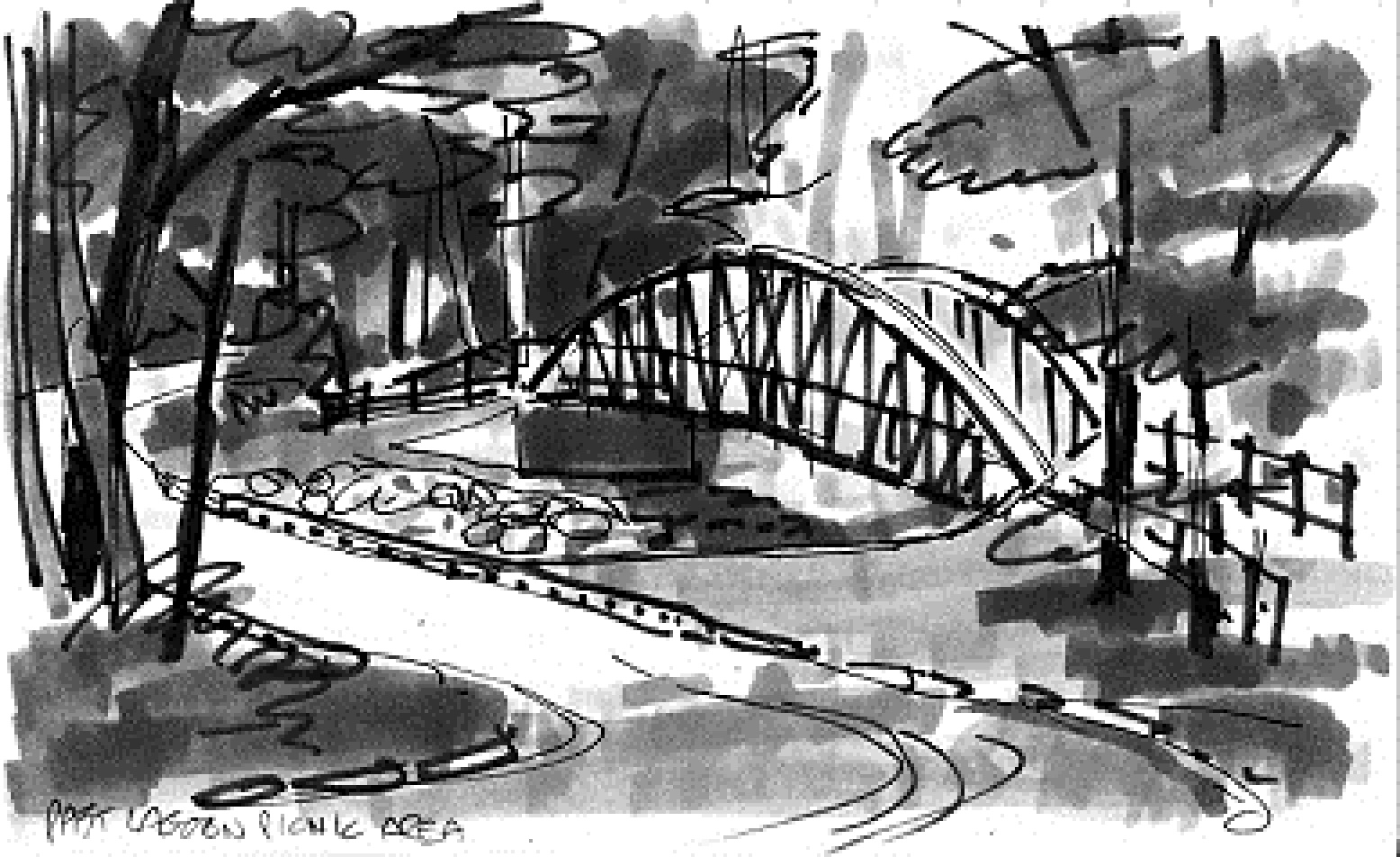 This 5 ½" x 8 ½" marker sketch (left) was made en plein air (i.e. outdoors) just prior to painting a watercolor of the same scene. It simplifies the value patterns and focuses on the main elements in the scene. Recommended brands: Design, Prismacolor, Sharpie, Chartpak, Pantone, Copic, Sakura.
This 5 ½" x 8 ½" marker sketch (left) was made en plein air (i.e. outdoors) just prior to painting a watercolor of the same scene. It simplifies the value patterns and focuses on the main elements in the scene. Recommended brands: Design, Prismacolor, Sharpie, Chartpak, Pantone, Copic, Sakura.
Drawing Materials: Pen, Brush, Ink
Ink Takes Commitment
...and in 2500 B.C., Egyptian papyrus scribes knew this well. The marks you can't take back is part of its mystique. Forethought or focused spontaneity are needed to work in ink, but you can learn that. Early inks were made of ingredients like soot, lampblack, charred bones, vegetable oils, and animal fats. In fact, many modern inks use the same raw ingredients the Chinese used to make fine sumi ink sticks back in 1200 B.C. Starting around 700 A.D., the quill (feather) pen became popular as a writing and drawing tool. Remnants of these days-past exist in such names as the crow quill pen nib. Crows had finer feathers than other popular pen fowls. Remember the penknife in the sharpener section? Original penknives were designed for trimming the nibs on your quills. 1) Assorted inks (photo above) 2) F. Soennecken 5 ½ round writing nib 3) Speedball D-3 nib 4) Hunt 102 CrowQuill Pen 5) Bamboo (reed) pens 6) #4 Red Sable round brush
Inks, Tools, and the Marks They Make
Inksoterica
- Nibs are the business ends of pens.
- The expressive qualities of quills raised fine penmanship and calligraphy to an artform that started during the Renaissance period.
- The use of liquid iron gall, bister, and sepia inks was widespread in the West by the 9th century.
- "India Ink" or "China Ink" are liquid black (lampblack) inks containing shellac. They dry waterproof making them suitable for mixed media use. Non-waterproof India inks were developed for use in fountain pens which first showed up in 1884 thanks to Lewis Waterman.
- Invented in 1938, ballpoint pens started their popular run by the 1950s. Currently, 14 million BIC Crystals pens are sold daily. Some artists work exclusively in BIC ballpoint. You might check the permanence of the ink before considering doing the same.
- In the 1960s, the Papermate Flair felt-tipped pen was introduced, followed by roller-ball and gel pens in the 1980s and 1990s. (I prefer a bolder 0.9mm roller ball for sketching.)
Fountain Pens and Rapidographs
1) Koh-I-Noor Rapidograph Pen - The free flowing ink and constant line thickness makes this style of pen popular with illustrators. 2) Waterman Fountain Pen - Nice fountain pens are a pleasure to hold when you can afford to treat yourself to one. 3) Rotring ArtPen Fountain Pens - These are artist-specific cartridge fountain pens available in several widths.
Bleeding Fish
Some inks are actually concentrated dyes that are mixed to make a black color. This non-waterproof ink separated out into green and red-violet, so I made use of the effect.
Expressive Penmanship
Ballpoint, Rollerball, and Felt Tip Pens
1) Bic Crystal classic ballpoint pen - You either have a drawer full of these or they keep disappearing. 2) Hippie style novelty ballpoint pen - Test your pens before you buy them. Don't go by looks alone. 3) Pentel rollerball pen - A thin line rollerball pen. 4) Pilot Precise Grip Bold rollerball pen - My current favorite black rollerball pen has a 0.9mm (bold) tip. 5) Original Papermate Flair felt-tipped pen - Good for sketching, the tip can dull easily. Not waterproof.
Recommended brands: Daler-Rowney, Dr. PH. Martin, Higgins, Pelican, Speedball-Hunt, Rotring, Koh-I-Noor, Winsor & Newton, Montblanc, Watterman, Bic, Papermate, Pilot, Pentel
Drawing Materials: Erasers
Erasers, Your First Best Friend
We all were introduced to the eraser with our first pencil. After that pencil met the paper and we realized we could flip the pencil, rub and remove the mark we made, things felt safer. We had a way to obliterate wayward lettering and "bad" drawings of one sort or the other. You learned that all erasers don't work the same. You learned that you can't really remove really dark lines or ink that well without damaging the paper. Maybe you learned the technique of bracing the paper with your other hand and erasing away from that anchor point so you wouldn't rub a fold into the paper or rip it altogether.
Eraser Test!
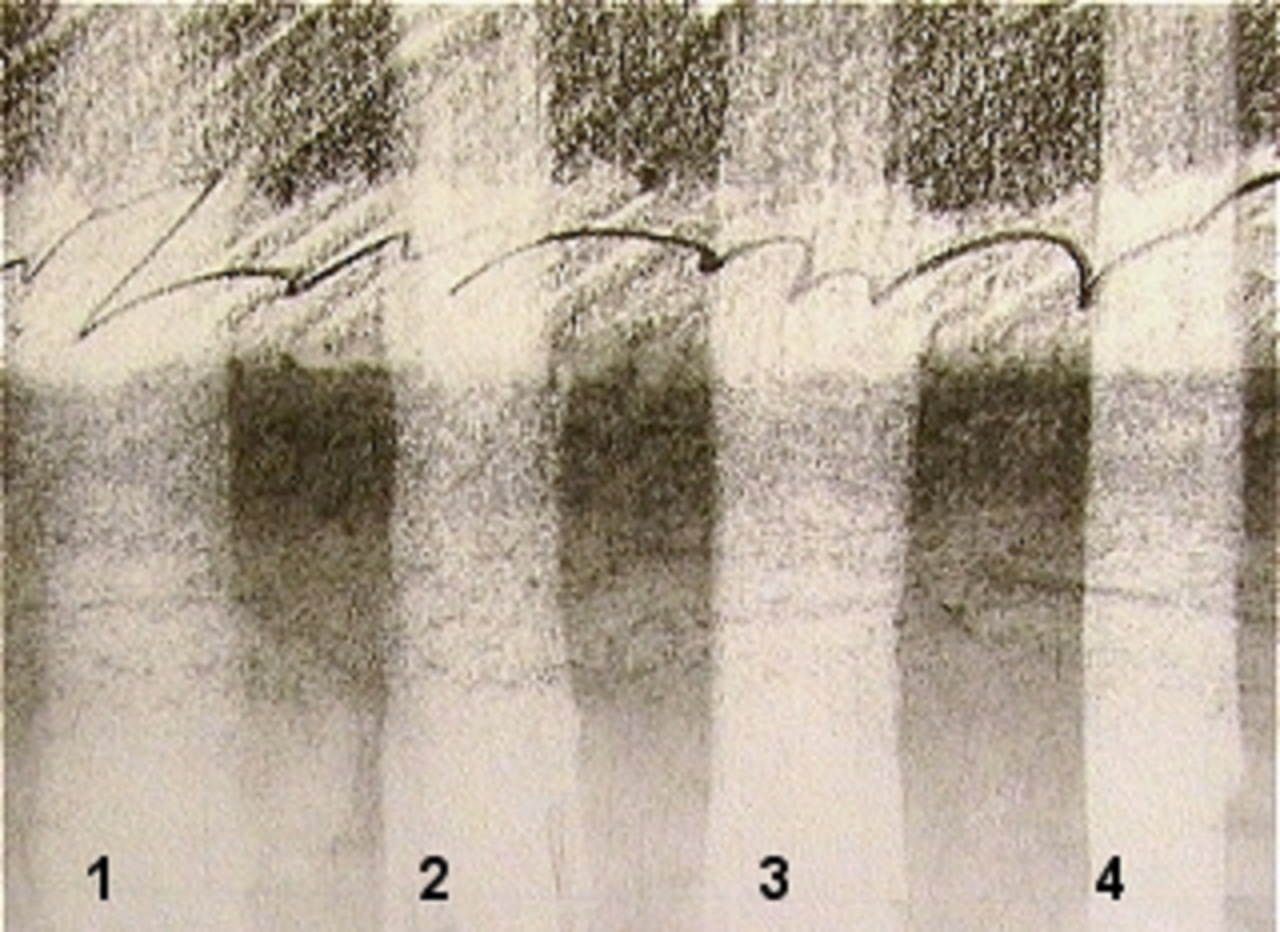
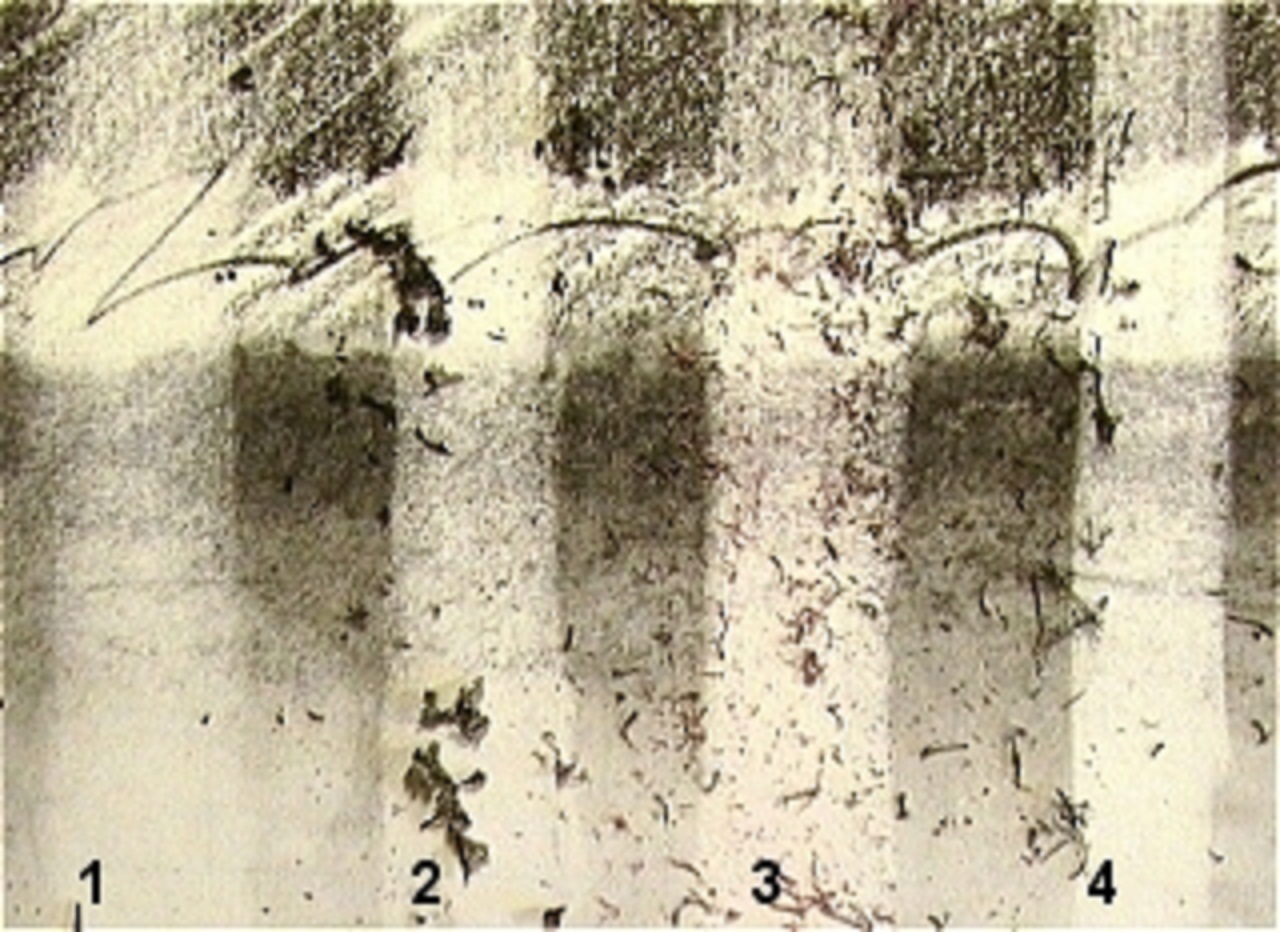 Testing was done on 100% cotton bond paper using an Ebony Pencil for the tones on the top and an Extra Soft charcoal pencil for the blended bottom tones. On the left you can see the amount of debris each eraser leaves behind as you erase. Once brushed off (pictured just above), you can see each eraser's effectiveness in cleaning and defining an edge in your drawing. Remember that over time, any area of the paper that was erased may slightly gray due to the mild abrasive and slightly acidic qualities of most erasers. The overall brightness of the areas will be affected with age also.
Testing was done on 100% cotton bond paper using an Ebony Pencil for the tones on the top and an Extra Soft charcoal pencil for the blended bottom tones. On the left you can see the amount of debris each eraser leaves behind as you erase. Once brushed off (pictured just above), you can see each eraser's effectiveness in cleaning and defining an edge in your drawing. Remember that over time, any area of the paper that was erased may slightly gray due to the mild abrasive and slightly acidic qualities of most erasers. The overall brightness of the areas will be affected with age also.
Kneaded Eraser (1)
Packaged as gray plastic wrapped squares, kneaded erasers hold true to their name. To soften a kneaded eraser, knead it with your hands, stretching and folding, twisting and shaping as you go. Good for cleaning up, shaping, or creating smudges, picking out soft highlights, and gently removing swaths of tone. You can remove the pencil lines from your thoroughly dry watercolor with a soft kneaded eraser. A kneaded eraser leaves no virtually no debris and is abrasive but much less so than Pink Pearl or ArtGum erasers. Kneaded erasers are composed of vulcanized vegetable oil (factice), natural and synthetic rubbers, pumice, and coloring agents.
Art Gum Eraser (2)
These are the original solid factice erasers which may contain modifiers and chalk. Art Gum erasers are about as abrasive as Pink Pearl erasers and will erase softer leads very well. They crumble easily as they erase and leave the most debris to brush away.
"Pink Pearl" Eraser (3)
These are the fairly abrasive pink rubber based erasers with the chiseled ends used for decades in schoolrooms everywhere. The main ingredients are the same as those for the kneaded eraser with variations in ingredients and formulation. The firmness allows you to use the edges to erase single lines and cut highlights into toned areas. Most yellow-barrelled pencils incorporate a form of this eraser on the ferruled end. Leaves a moderate amount of fairly tenacious pink debris and sometimes colors the paper.
White Vinyl Erasers (4)
White vinyl erasers come in a solid white rectangle and erase thoroughly with a high degree of edge control. The Mars Plastic eraser used here is composed of polyvinyl-chloride (PVC), calcium carbonate (chalk), chloride, and coloring agents among other ingredients. On softer leads they tend to smudge up the pencil line a bit before cleanly rolling it away. Low to moderate eraser debris is easy to clean up. These are the least abrasive erasers, have a neutral ph, and do not abrade sized papers at all.
Ink Eraser (not pictured)
These are the other rubber based erasers with the chiseled ends used for decades in schoolrooms everywhere. Usually divided into white and gray halves with different abrasive qualities. Because they are so abrasive, they really have no use in drawing unless utilized as a tool for working on clayboard or scratchboard.
Electric Eraser (not pictured)
These vibrating wonders can be fitted with a variety of grades of eraser heads. Commonly found in an architect's office, electric erasers can be used as part of your drawing kit if that's what you need to do what you do. Recommended brands: Sanford, Papermate, Staedtler, Tombow Mono, Radar.
Drawing Materials: Blending Tools
Touching Your Art
Sometimes you use smudging as a technique with charcoal or soft graphite drawings to soften focus, spread tones and values, and draw. Your fingers and palm of your hand are just wonderful for manipulating loose pigment and dust on your paper. If you wish to keep your fingers clean, wrap your finger in tissue, or wad the tissue into shape and blend away.
Stumps (1)
Stumps are dual-pointed sticks of tightly rolled felt-like paper made for spreading and blending charcoal, pastels, and graphite pencil. They are available in a large range of thicknesses.
Chamois (2)
Chamois is soft processed suede leather that you use as a blending or drawing tool. Try wrapping your finger in a small square of chamois and working with some powdered charcoal or graphite on a large piece of paper.
Tortillons (3)
Tortillons are loosely rolled-up points of soft paper made for spreading and blending charcoal, pastels, and graphite pencil. Tortillons have a longer single taper that is somewhat flexible like a brush.
Brushes (not pictured)
Soft sable brushes, natural hog bristle, synthetic, make up brushes, foam pads, even house painting brushes can be used for very delicate smudging and blending.
HINTS AND TIPS:
- To avoid smudging a drawing while working on it, lay a clean scrap of paper under the heel of your drawing hand to protect the drawing underneath.
- As you use your blending tool experiment with your angle of attack. Tortillons have a wider range of stroke widths. Stumps have shorter angled points and a more limited range of width.
- Once a stump or tortillon is saturated with the media you are using you can draw with it.
Drawing Materials: Sharpeners
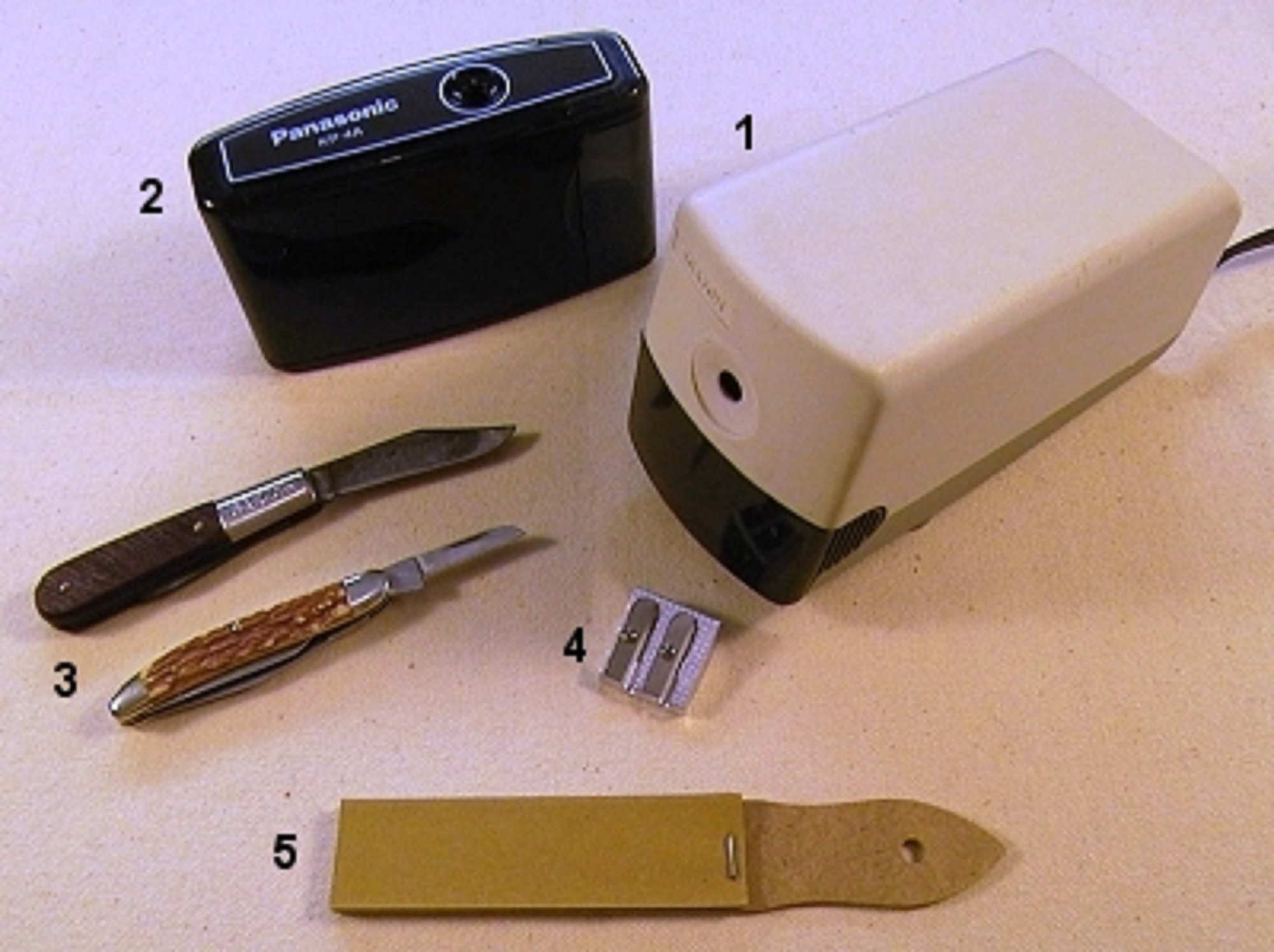 There are a variety of sharpeners for your drawing tools; some are easier than others, some require caution and practice.
There are a variety of sharpeners for your drawing tools; some are easier than others, some require caution and practice.
Electronic Sharpeners (1 & 2)
Plug-in desktop or portable electric sharpeners are by far the easiest to use, but they require consumable energy sources. I use them in the studio. The plug-in desktop models can gnaw through an entire pencil in seconds. FYI: Sharpening too many waxy pencils can gum up the works as the blades heat up. Sharpen a regular #2 pencil a few times to clear up sharpener clogs.
Knives and Blades (3)
Penknives or mat knives are easy to use if sharp, but you must carefully practice to become competent. See the "How to Sharpen a Pencil by Hand" instructions below.
Manual Sharpeners (4)
Hand-twist metal-blade sharpeners are available in single and double formats. Some have replaceable blades. Choose a high quality metal sharpener with sharp blades. These usually work very well but leave a big curly mess to clean up. Some remove only the wood so you can sharpen the tip separately on sandpaper. If the wood splinters as you twist, you either have a dull blade or a cheap pencil. TIP: Rotate the sharpener around the pencil to get a nice, even point! Turning your pencil inside the sharpener makes the lead more likely to break or become off-center.
Sanding to a Fine Point (5)
Sandpaper pads are designed for shaping or sharpening leads in mechanical clutch pencils. Sandpaper can quickly refresh a point on your pencil between sharpenings. As a sheet gets dirty with use, you can peel it off to expose a fresh sheet of sandpaper.
The Old Classroom Standard (6)
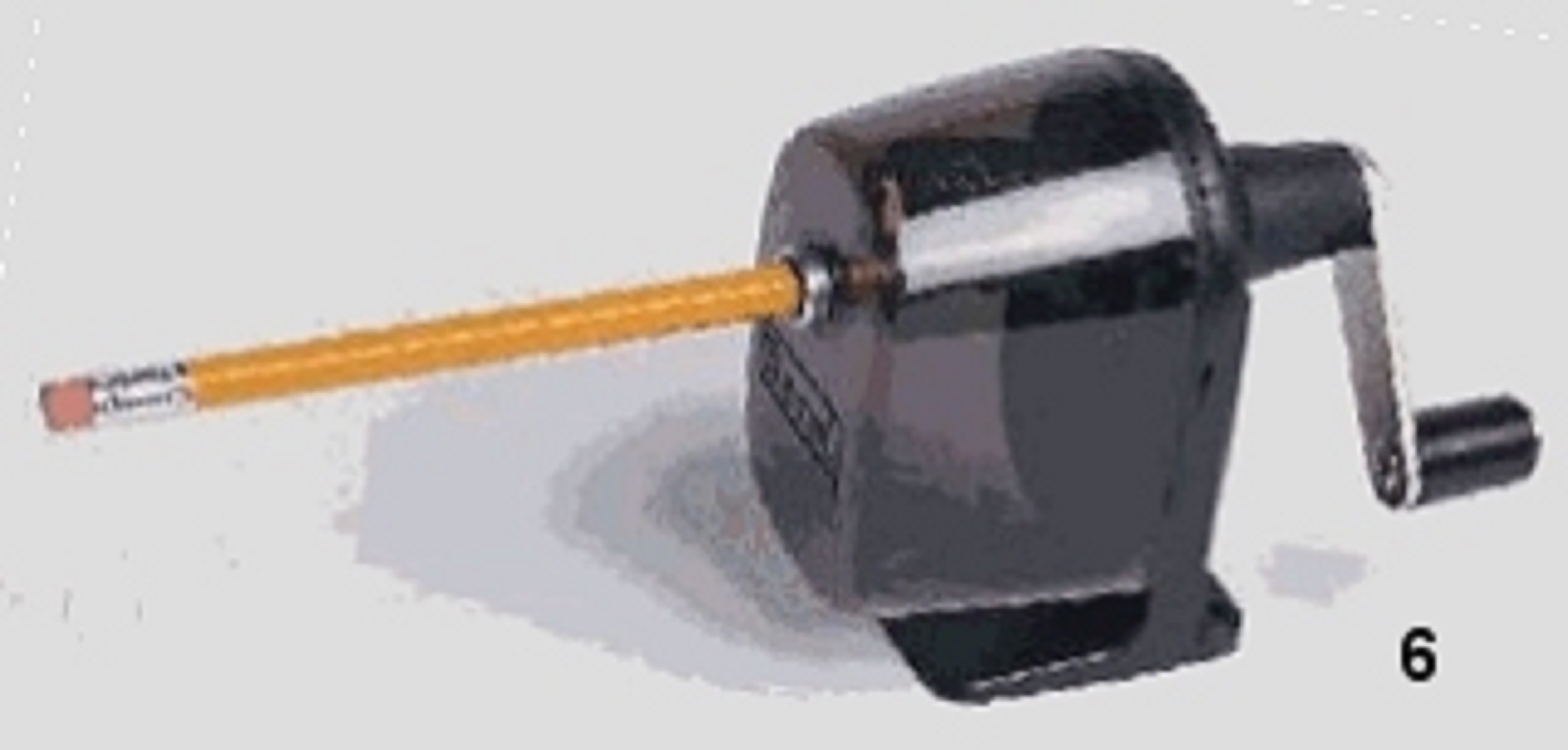 One of the easiest manual pencil sharpeners to use, most school rooms have (or had) one mounted at kid level. A fairly inexpensive and practical investment if you draw a lot. Deluxe models handle larger diameter pencils. (Apologies for the rather odd looking photo above. It was free and the US Government paid for its creation.)
One of the easiest manual pencil sharpeners to use, most school rooms have (or had) one mounted at kid level. A fairly inexpensive and practical investment if you draw a lot. Deluxe models handle larger diameter pencils. (Apologies for the rather odd looking photo above. It was free and the US Government paid for its creation.)
*Please Read Before You Bleed*: How to Sharpen A Pencil By Hand
- If you're a grown up, be careful. If you're a kid, tell your grown up to be careful, too.
- Proceed at your own risk.
- Always use a SHARP penknife or mat knife. Sharp knives cut smoother and are easier to control.
- DO NOT use an X-acto knife. Their thin handles offer a poor grip for controlling your cuts.
- KIDS: Do not try this by yourself! Use a pencil sharpener or have an adult do this for you. Knife cuts are messy, they hurt like heck, and they're embarrassing. Trust me.
Drawing Materials: Mechanical Aids
You Gotta Draw the Line Somewhere
So you're dealing with imagery that you place on a 2D surface and you have to place a very straight edge on one of the items of your composition. What to use? A ruler. It focuses your pencil on the straight line truer than your hand alone does. So why fight it? Use what you need.
Rulers
I use metal rulers in the following lengths: 18", 24", and 36". The 24" and 36" rulers are 1/8" thick aluminum that is ideal for cutting straight cuts in heavier papers and mat board. The 18" is a thinner gauge ruler I use for measuring and drawing.
T-Squares and Triangles
If you are working on complex perspective work, sometimes it pays to square up your paper on a drawing board, secure it, and use a T-square to draw your horizontals and a triangle to draw your verticals. T-Squares are available in wood, plastic, metal, or combinations of the three. Triangles come in a couple different angle sets: 30-60 and 45-90 degrees. The size and color choice is up to you, most are transparent plastic of varying grades.
The Compass, the Curve, and the Protractor
If you need a circle of a certain size and you don't have the right sized can to trace, a compass is a handy thing to have. A cheap (under $1) pencil-holder compass should serve most needs. French curves are used for drawing smoothly curved lines of various shapes. There's a protractor tacked to one of my bulletin boards to remind me which angle is which when I'm manipulating images in a paint program. Recommended brands: Alvin, Fiskars, Grifhold, X-Acto, Staedtler, C-Thru, Gaebel, Discovery, Empire, Mars, Acme, Chartpak.
Drawing Materials: Fixatives
Nothin' Like the Smell of Fixative in the Morning...
To keep your finished drawing from smearing, you should lightly spray it with a good fixative. Most fixatives allow you to draw over the fixed work without disturbing the drawing underneath. Traditional fixative is made from casein, alcohol, and water. It is easily applied with an atomizer. Casein, the colorless dairy-based medium used in casein paints, dries to form a light waterproof coating that binds the drawing media to the paper. Modern fixatives are polymer-based and contain volatile chemicals such as acetone and toluene. Some brands of fixative really reek up a room and the smell can cause headaches, dizziness, and nausea in individuals. Use fixatives in a well-ventilated room away from hot water heaters, furnaces, and any open flames.
A Mere Shadow of Itself
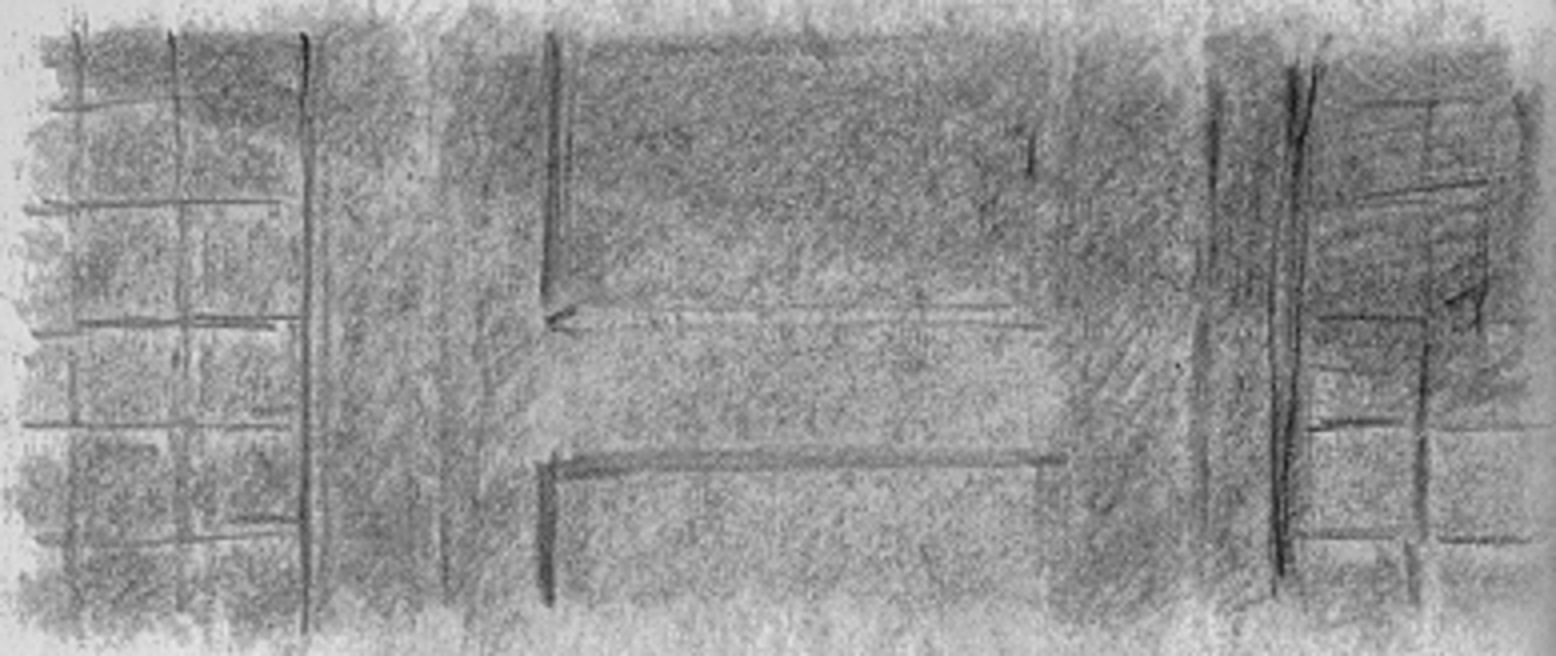 This preliminary sketch spent 20 years in the first few pages of a sketchbook I have. I didn't bother to spray it with fixative when I made it. This was a graphite value study for the lithograph below. ...and it didn't start out all gray.
This preliminary sketch spent 20 years in the first few pages of a sketchbook I have. I didn't bother to spray it with fixative when I made it. This was a graphite value study for the lithograph below. ...and it didn't start out all gray.
What it Was
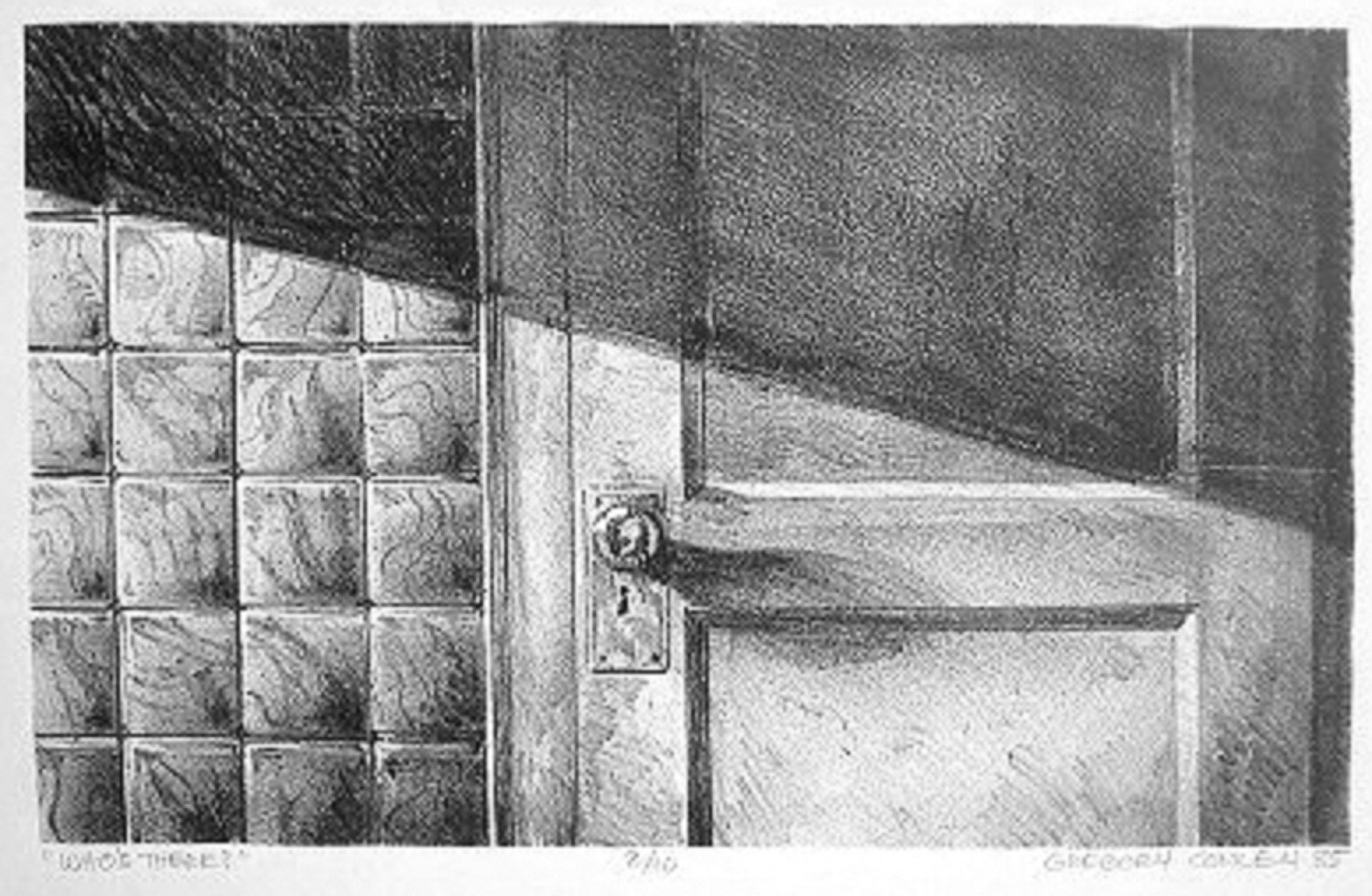 The stone lithograph "Who's There?" was based on the fresh version of the above sketch. What first struck me in this image was the creepy raking side lighting and dramatic shadows in a kitchen at night. The print still preserves this feeling. The contrasts in the sketch have ground themselves into a hazy sea of gray over time. Moral: If you don't fix it or frame it, its glory, however meager, may be short-lived. Recommended brands: Alvin, Fiskars, Grifhold, X-Acto, Staedtler, C-Thru, Gaebel, Discovery, Empire, Mars, Acme, Chartpak.
The stone lithograph "Who's There?" was based on the fresh version of the above sketch. What first struck me in this image was the creepy raking side lighting and dramatic shadows in a kitchen at night. The print still preserves this feeling. The contrasts in the sketch have ground themselves into a hazy sea of gray over time. Moral: If you don't fix it or frame it, its glory, however meager, may be short-lived. Recommended brands: Alvin, Fiskars, Grifhold, X-Acto, Staedtler, C-Thru, Gaebel, Discovery, Empire, Mars, Acme, Chartpak.
